






















Educators, you are the guiding lights of our schools - lighting the way for our students with wisdom, dedication and heart. Now, it’s time to shine the spotlight on YOU!
We congratulate all the educators who were nominated and are pleased to announce the following educators receiving awards this year.
Sam Kahan Distinguished Educator for Excellence in Jewish Education
Ahuva Schachter
JEWELS
Early Childhood Teaching Excellence Award
Maia Bar- Am
JCC Stoler Early Learning Center
Gladys Ricklis
Ohr Chadash Academy
Student Support Award
Rabbi Uri Rabinowitz
Binyan Yisroel
Ahavat Tzion Award
Rabbi Lowell Brazin Krieger Schechter Day School
Excellence in General Studies Award
Rachel Shar Ohr Chadash Academy
Inspiring Educator Award
Eeta Travis
Talmudical Academy
Innovative Educator Award
Adrienne Reicher
Goldsmith Early Childhood Center
Congregational School Educator Award
Erez Haluf
Beth El Congregation
Educational Leadership Award
Gitti Horowitz
Bais Yaakov Middle School
The Robin F. Jacobs Student
Achievement Award
Chaim Leeder
Talmudical Academy, 5th grade
Join us for an inspiring and celebratory evening as the Baltimore community comes together to honor the outstanding educators who make a lasting impact in our Jewish schools.
Monday, May 12 • 7:00 - 8:30 p.m.
Suburban Orthodox Congregation
Questions or need special accommodations? Contact Terri Rosen at tnrosen@jesbaltimore.org or 410-735-5008.
We welcome participants of all abilities.

Register today at bit.ly/ CelebratingEducation2025 or scan this code.
Follow us on Facebook @JewishEducationalServices and on Instagram @jesbaltimore
The Chesed Fund & Project Ezra, in conjunction with DMAC Security & Croustille Café, present:
2
Pick up your CPSC certified helmet for only $8
(Price includes tax. Valued at $16.)
Agree to wear your helmet whenever riding a bike, scooter, or skateboard.
3
*After the sale, helmets will be available at Hats to Hose. Cost will be $9 per helmet. No coupons will be available. +=
Receive a coupon for a FREE Croissant or Muffin from Croustille Café
(Coupon valid 5/4/25-6/27/25.)
This special sale price is available one day only!*
Sunday, April 27th, 2025
FREE LED Bike Light Set (Valued at $5) In memory of
Parking Lot
10am - 4pm Limited supply available.
All Helmet Sizes Available in Red, Green, or Blue.
TODDLER SIZES: XS
CHILDREN SIZES: S/M or L/XL
ADULT SIZES: ONE SIZE FITS ALL
Credit card, check and cash accepted! If paying by check, please prepare ahead of time and make check out to Project Ezra.
This initiative is dedicated in loving memory of Barry Rosenbluth, ה׳׳ע.
This week, as we are in the midst of Sefira, I’m reminded of a special connection in our family, particularly through my late great uncle, R’ Shaya Gluck. A few years ago, my in-laws had the privilege of traveling to Eretz Yisroel, where they visited Uncle Shaya, who was celebrating his 98th birthday. The photos from his birthday party captured a man who had lived through so many lifetimes of hardship yet radiated a quiet strength. Born in Hungary in 1925, Uncle Shaya experienced the horrors of the Holocaust, surviving concentration camps and unimaginable suffering. After the war, he married but, unfortunately, was not blessed with children. In his later years, he settled in Eretz Yisroel, making the most of his solitude and reflecting on a life of perseverance.
Uncle Shaya’s story is deeply intertwined with the legacy of R’ Shayala from Keristir. Interestingly, Uncle Shaya was born just one week after the passing of R’ Shayala. It’s said that he was the first to bear the name of Reb Shayala, and he carried it proudly, embodying the essence of the holy man who was known for his boundless love for every Jew. Reb Shayala’s legacy is not only remembered for his miraculous Yeshuos, which many still merit by visiting his Kever today, but for the way he lived his life – a life devoted to selfless Ahavas Yisroel. It was this
deep and universal love for every Jew that set him apart and had a lasting impact on his generation, an impact that continues to resonate with us today.
As we are in the midst of Sefira, the central theme of Ahavas Yisroel, loving our fellow Jew, becomes even more poignant. In a world where many face struggles, isolation, and pain, we have the opportunity to make a difference through simple acts of kindness. Reb Shayala’s unwavering empathy and care for every Jew, regardless of their background or circumstances, offer a powerful lesson for us all. Whether through a word of encouragement, an act of tzedaka, or just a moment of companionship, we can all bring a little more light into the lives of those around us.
In honor of the Yahrtzeit of R’ Shayala and my beloved Uncle Shaya, whose life reflected many of his namesake’s virtues, let’s commit ourselves to reaching out to those who may need it most. A small gesture of kindness, in their zechus, could mean the world to someone in need. Wishing you all a peaceful Shabbos, Aaron M. Friedman
Comfort Year-Round:

Save Big on Energy Costs:
Cut your heating and cooling bills by 30-50% and make your HVAC system work smarter, not harder.
Breathe Better:
Enjoy improved air quality with reduced drafts and outdoor pollutants, creating a healthier living environment.


After collecting Pride of the Farm ice cream, stretchy, stress-relieving bananas, Lasdun-sponsored custom pen and flashlight sets, Tov Pizza memorabilia, yummy Candy Store offerings, Award-Winning O’Fishel To-Ah-Meh-Ha cholent, O’Fishel burger/hotdog boxes, and soup cups, 500 Bracha Out-Louders between ages 2–119 descended on Mitzvah Mo Worldwide Headquarters to celebrate and make more Brachos at the 20-something-or-other All-TheBrachos-You-Can-Make Buffet and Catch-A-Welcatch for a Yiddish-Kite. Those who were careful to document 100 Brachos that they recited in one day in chronological order were awarded with an O’Fishel Bureau of Engraving Portrait of Andrew Jackson (aka, a tzventzigger).
Honored guests enjoyed a lavish buffet of O’Fishel Beef-A-Roni, Sesame Chicken, BBQ Pulled Chicken, besides the requisite Kosher Dawgs and Burgers, and Ronnie Askew’s world-famous multi-flavor Snowballs!
The Seudah was graced with Divrei Chizuk by the Marah D’Asra

of Mitzvah Motivators, Rabbi Dovid Heber, reminding us that this year we will have YAKNEHA on Acharon Shel Pesach, and the next time this happens, in two decades, many Mitzvah Motivators will be bringing their own children to the buffet, iy”H, B’mheira yibaneh Bais Hamikdash in our Yerushalyim location – you bring the Todah, we’ll bring the soda!
You too can be a Mitzvah Motivator by making your Brachos out loud, thus encouraging others to do the same. A present Mitzvah Motivators program includes Know Makkos Now. If you would like to sign up for Makkos ASAP, visit mitzvahmo.com. If you would like to be a sponsor for the upcoming Summer Masmidim program, please email us at mitzvahmo@gmail.com.
As we enter our second quarter-century of Mitzvah Motivation, the Board of Directors, Ladies Auxiliary, sponsors, and volunteers of Mitzvah Motivators wish everyone a Chag Kasher V’Sameach. Please note the special, rare Brachos made only on Seder night, and don’t forget the special Bracha on the trees in Nissan.




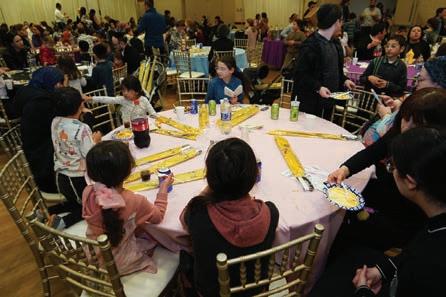

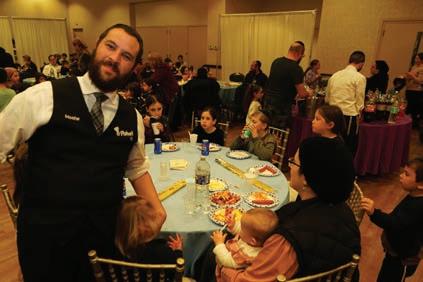





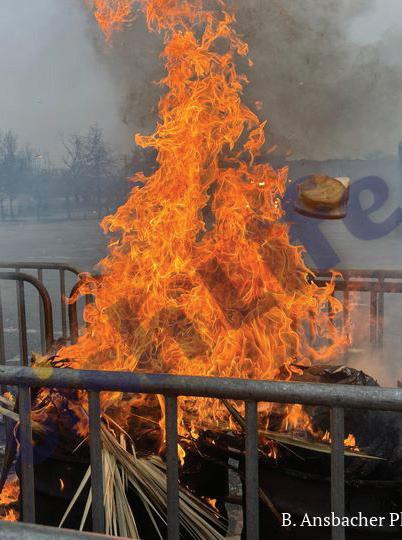


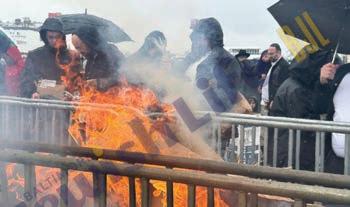





imadi is a Maryland-based organization dedicated to supporting children facing a life-changing medical diagnoses – and just as importantly, their entire family unit. Through concierge case management, community building, social-emotional support, and pediatric patient advocacy, imadi stands as a North Star for their families, creating a magical space where even in their darkest moments, there is hope.
Their model is simple, but powerful: by engaging families with a thoughtfully curated and trauma-informed support modality, families receive a custom-tailored experience that addresses emergent needs with creativity, compassion, and community. At imadi, one thing is clear – they don’t believe in doing things simply because that’s the way it’s always been done. Their team, under the leadership of Tzvi Haber, constantly challenges the status quo to ask themselves - and the greater community - what do we think our families need, and what do our families actually need. How can we do more?
This year, that mindset led to one of their biggest pivots yet.
“Every year, community organizations (imadi included) host pre-Purim parties – festive, fun, and largely similar to the dozens of other events families could attend around the city”, said Shevy Klein LMSW, imadi’s Case Manager for families living in Baltimore, “we realized that for imadi families, these parties weren’t filling a real need. They already had optionsat the shul or school - and our families,
balancing overwhelming medical and logistical challenges, needed more than “just another party.” What they actually needed was... real support to help easing into what often can be an intense Pesach season. Parents were desperate to have a few hours of respite… or a few hours to prepare for what often can be the most stressful chaggim of the year.”
And so, imadi made a bold move: they pivoted all of their energy and investment into a brand new initiative – the pre-Pesach FREEDOM FEST.
Freedom Fest was not simply a glorified pre-Pesach camp. It was a full week-long immersive experience, packed with daily programming for all imadi clients – children with a diagnosis and their siblings. Their goal was to create an oasis of fun and, more importantly, structure for children in the imadi community at a time when many parents are feeling stretched thin because their children are home from school.
The results were nothing short of extraordinary.
Over the course of one week more than 200 imadi clients and 115 high school student volunteers participated in daily outings and programs. Recognizing that arranging transportation to events can often be a barrier for parents, especially those juggling multiple children, medical equipment, and complicated schedules, imadi arranged bus transportation - to and from events - from multiple locations in Pikesville and Kemp Mill.





Openden-Rosenbloom, imadi’s Program Coordinator, shared just how impactful the week truly was. "It was incredible," she said. “Adventure Park USA, Wonderfly Arena, ClimbZone, Sky Zone — every day was packed with excitement. Thanks to the full-day programming, imadi offered parents nearly five hours of true respite each day — giving them the rare gift of time to focus on Pesach preparations, care for other needs, or simply breathe, knowing their children were happy, safe, and cared for.”
Some of the most beloved - and innovative - parts of Freedom Fest were the Afikoman Gift Shop, a magical pop-up shop where parents had the chance to “shop” for special gifts for their children to be entertained over the

long school break. They even hosted a Breakfast for Champions on Friday morning - just hours before Pesach began – featuring a deluxe breakfast buffet where parents could bring their kids to eat a hearty, delicious meal at a time when many homes are already turned over for the holiday and the kitchen is bare. And, true to the heart of imadi’s mission, every single part of Freedom Fest was offered free of charge to participating families.
One mother ’s words perfectly captured the impact of Freedom Fest: “Making Pesach is overwhelming. Making Pesach with a child who has significant medical needs is beyond overwhelming. But making Pesach with imadi by my side? That’s a blessing like no other.”









The spirit of Torah and unity lit up the community this past Chol Hamoed Pesach as Dovid Wolvovsky, son of R’ Berel and Rebbetzin Chaya Wolvovsky, completed a monumental Siyum HaShas. This incredible achievement was celebrated with great joy and reverence, drawing community members and leaders together in a beautiful display of Kavod HaTorah.
The siyum was not just a personal milestone for Dovid, but a communal celebration of dedication, perseverance, and love for Torah learning. The event was graced by powerful words of chizuk and inspiration from distinguished Rabbanim, including Rabbi Wolvovsky, Rabbi Lopainsky, Rabbi Rosenbaum, and Rabbi Frank. Each speaker highlighted the significance of the moment and the tremendous effort that went into reaching such a lofty goal.
The atmosphere was electric with simcha and pride, as attendees were uplifted by the occasion. The event served as a true inspiration to all present, showcasing the beauty of lifelong learning and the deep impact of Torah commitment on both individuals and their communities.
Mazal Tov to Dovid and the entire Wolvovsky family on this remarkable accomplishment. May this be the first of many milestones in a life filled with Torah, mitzvos, and continued aliyah.


2nd/3rd


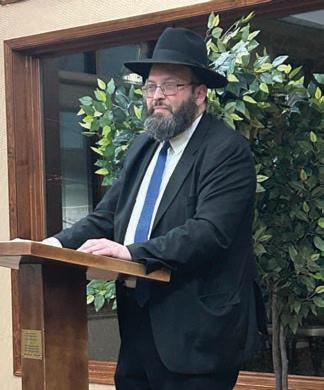
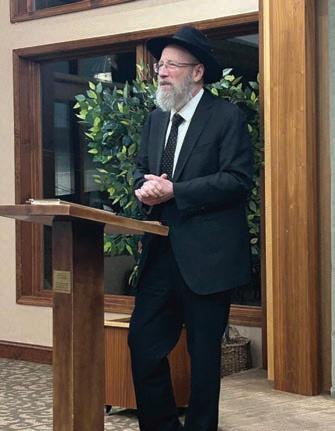
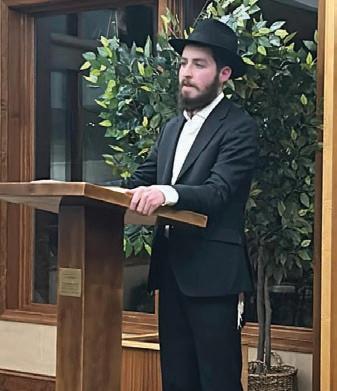





Let’s Connect!, a new community initiative for vibrant women 55+ who engage in meaningful, spiritual & social connections, will be holding its inaugural event on May 4. We sat down with Mrs. Sara Brejt, a member of the Let’s Connect! steering committee, to learn more about this exciting Baltimore program as well as to get details about the May 4 event.
BJH: Since you are a new organization, can you please introduce yourself to the Baltimore community? What are you about? Whom are you planning to include?
LC: Thank you. We are a social organization for vibrant women who are approximately in the 55+ age range. We are creating a community to thrive as we reach this new age and stage. It’s an opportunity to broaden and expand our horizons, to tap into our strengths and discover new and dormant talents.
We welcome the newfound time and flexibility, to explore more varied social circles and interests, by taking part in a variety of activities with like-minded women. For many - though not all - of us, we are moving away from decades of kids-centered schedules.
next chapter in life, when we believe the best is yet to come!”
BJH: Who thought of this marvelous idea? How did it come about?
LC: Reb. Teichman had suggested this idea to Dr. Moshay Cooper, Mrs. Chaya Dachs, Mrs. Goldie Silberberg and me. We have also reached out to numerous other women, across the community, to spread the word and to help in other organizational roles.
BJH: Can you describe how this program will work?
LC: We see the program as having two main components.
First, we expect to have larger events, such as the inaugural one on May 4, that will have general appeal to a wide range of women in our age demographic.
Secondarily, we want to have a few series of smaller get-togethers. These would revolve around specific ideas, with appeal that is more focused. Current suggestions on the table include arts & crafts, book clubs, health & wellness and volunteer opportunities.
is empowering and uplifting”.
Our Rabbinic advisors, Rabbi Dovid Heber of KAYTT and Rabbi Binyomin Marwick of Shomrei Emunah have been very positive and encouraging as well. All in all, it feels like an idea whose time has certainly come.
BJH: Please tell us more about your May 4 inaugural event. It sounds like you’ve put a lot of thought into it.
LC: Thank you. We’re very excited about it. It will be held on Sunday May 4, 2-4pm at the Storch Pool House in the rear, at 3209 Fallstaff Rd.
The three parts of the program will reflect our organization’s motto: “It’s All about Our Connections.”
• Connecting with Hashem will feature a conversation with the delightful Mrs. Estelle Levitas, Baltimore’s “Oldest Ba’alas Teshuva”, who appeared on the popular Inspiration for the Nation podcast.


Also, speaking of moving, Baltimore is home to a large contingent of “older” new transplants who have moved here. Let’s Connect! can provide the opportunity for making new friends that carpools and PTA’s may have provided in the past.
As Reb. Chasida Teichman has said: “The freshness of this venture, new to Baltimore, is an exciting way to embark on the
This will be a peer-based organization and, of course, we are open to additional input and suggestions.
BJH: What has been the community response so far?
LC: Actually, it has been overwhelmingly positive! From short encouraging phrases like, “this is so needed” and “I can’t wait”, to more thoughtful, expanded validation like, “anything that supports and encourages friendships, as women enter new life stages,
• During Connecting with Ourselves, Baltimore’s very own Mrs. Judy Landman will lead us in a Writing Workshop titled: “Write For You”. She is the author of the warmly-received book of poetry, Seasons of the Rain.
• Lastly, we will Connect with Each Other, and meet our Baltimore neighbors - new and old - in an invigorating speed-meeting activity.
The entrance fee is $10 and pre-registration is appreciated because space is limited. Please register at bit.ly/RegisterMay4. Registration questions can be addressed to Mrs. Chaya Major at 720-422-6600.
BJH: Since this is a new program, how do you expect people to find out about it?
LC: We see that the enthusiasm has already generated a certain “buzz”. We expect that the word-of-mouth will continue to be contagious.
BJH: If someone wants to be updated about your organization, what should she do?
LC: Thank you, to be put on our email list to get updates about future happenings, please email us at letsconnectbaltimore@ gmail.com. We also welcome suggestions, inquiries and offers of assistance to that email address.
BJH: We wish you much hatzlacha with this undertaking and with the May 4 program.


Last week, former Peruvian president Ollanta Humala and his wife, Nadine Heredia, were both sentenced to 15 years of jail time after they were convicted of money laundering and receiving illegal campaign contributions.
Along with their youngest son, He-
redia, the 48-year-old former first lady, fled to the Brazilian Embassy, where she sought asylum under Brazil’s 1954 Convention on Diplomatic Asylum with Peru. Humala, on the other hand, was imprisoned immediately after he was sentenced, as per a judge’s order.
Humala, a 62-year-old former army commander, served as president from 2011 to 2016. Authorities charged him and his wife with receiving nearly $3 million in illegal contributions as part of his campaign in 2011. Most of the money, authorities claim, came from Odebrecht, a Brazilian construction conglomerate connected to many bribery cases in Latin America. Officials from Peru also allege that Hugo Chavez’s Venezuelan government funded Humala’s failed 2006 campaign with hundreds of thousands of dollars, another charge for which the former Peruvian president was convicted. He and his wife have maintained that they’re innocent.
Over the past two decades, five other former Peruvian presidents faced imprisonment, while two others, aside from Humala, were jailed. The former presidents were detained in a former
police academy on the outskirts of Lima. Also implicated in Odebrecht-related scandals were former presidents Alejandro Toledo, who served from 2001 to 2006 and received a 20-year prison sentence a year ago for taking approximately $35 million in bribes; Alan Garcia — the president in the 1980s and 2000s — who took his own life in 2019 just as officials came to his home to arrest him; and Pedro Pablo Kuczynski, Humala’s successor, who has been under house arrest for years, though the investigation is still ongoing. Additionally, Alberto Fujimori, an authoritarian president, was imprisoned for over 10 years for human rights abuses and corruption and was freed in 2023 as a result of a controversial pardon from the president. Peru’s first leftist president in a long time, Pedro Castillo, is currently facing charges of rebellion of abuse of authority because he, in 2022, attempted to shut down Congress and put into power an emergency government.
Peru’s government said it did not take issue with Brazil’s decision to take in Heredia as an asylum seeker, with the Peruvian foreign ministry claiming that
it provided the former first lady and her son a safe transfer out of the country.
Pope Francis passed away on Monday at the age of 88, just around four weeks after his release from the hospital, where he came close to death while battling respiratory problems. He was the 266th pope, having risen to power in 2013. Francis passed away at 7:35 a.m. local time.
On February 6, the pope’s bronchitis diagnosis and his trouble speaking and breathing forced the Vatican to cancel many of his events. Eight days later, Francis was hospitalized in Rome. He received a diagnosis of double pneumonia four days later.
Then, on the night of February 28, his health worsened. The Vatican said he had experienced several “acute respiratory insufficiency” attacks. His condition was so bad that the doctors thought about stopping treatment and letting the pope pass away peacefully. Thirty-eight days after he was hospitalized, Francis returned to
6:15 am Young Israel Shomrai Emunah M-F
6:25 am Southeast Hebrew Cong., Knesset Yehoshua M-F
6:30 am Beth Sholom Congregation M-F
Beit Halevi (Sfardi) M, T
Chabad of Silver Spring M-F
Ohev Shalom Talmud Torah OLNEY M-F
Young Israel Shomrai Emunah S YGW M, Th
6:35 am Ohr Hatorah M, Th
6:40 am YGW S, T, W, F
Magen David Sephardic Congregation M-Th
6:45 am Beit Halevi (Sfardi) S, T, W, F
Kemp Mill Synagogue M, Th
Ohr Hatorah T, W, F
Young Israel Shomrai Emunah M, Th
6:50 am Woodside Synagogue/Ahavas Torah M, Th Silver Spring Jewish Center M-F
Chabad of Upper Montgomery County M-F
6:55 am Young Israel Shomrai Emunah T, W, F
7:00 am Kemp Mill Synagogue T, W, F
Southeast Hebrew Cong., Knesset Yehoshua S Silver Spring Jewish Center S
POTOMAC
BETHESDA Magen
Sephardic Congregation [S]
Woodglen Dr, North Bethesda, MD 20852
GAITHERSBURG
Chabad of Upper Montgomery County [Ari] 11520 Darnestown Rd, Gaithersburg, MD 20878
OLNEY
Ohev Shalom Talmud Torah (OSTT)
18320 Georgia Ave, Olney, MD 20832
Woodside Synagogue/Ahavas Torah T, W, F
Young Israel Ezras Israel of Potomac T, W, F
7:05 am Kesher Israel M, Th
7:15 am Kemp Mill Synagogue M, Th Kesher Israel T, W, F
Ohev Sholom Talmud Torah/The National Synagogue M-F
Ohr Hatorah S
7:30 am Chabad of DC M-F
Chabad of Potomac M-F JROC M-F
Kemp Mill Synagogue T, W, F
Southeast Hebrew Cong., Knesset Yehoshua M-F
Young Israel Shomrai Emunah S
Young Israel Shomrai Emunah (Sfardi) M-F
7:45 am YGW (Yeshiva Session Only) S-F
8:00 am Beth Sholom Congregation S
Kemp Mill Synagogue S Kesher Israel S
Ohev Shalom Talmud Torah OLNEY S
Southeast Hebrew Cong., Knesset Yehoshua S
Chabad of Upper Montgomery County S Woodside Synagogue/Ahavas Torah S
8:00 am YGW (High School; School-Contingent) S-F
Young Israel Ezras Israel of Potomac S Young Israel Shomrai Emunah (Sfardi) S
8:05 am Ezras Israel Congregation of Rockville M, Th
8:15 am Ohr Hatorah S Ezras Israel Congregation of Rockville S, T, W, F Kehilat Pardes / Berman Hebrew Academy S-F Silver Spring Jewish Center M-F
8:30 am Chabad of DC S Chabad of Potomac S JROC S Ohev Sholom Talmud Torah/The National Synagogue S Silver Spring Jewish Center S YGW (Summer Only) S-F
8:45 am Young Israel Shomrai Emunah S-F
9:00 am Chabad of Silver Spring S Kemp Mill Synagogue S
mincha
2:15 pm Silver Spring Jewish Center S-F
2:20 pm YGW M, T, W
2:45 pm YGW M-Th
3:00 pm YGW Middle School School Days
Before Shkiah (15-18 minutes), S-TH
Beit Halevi (Sfardi)
Beth Sholom Congregation
Chabad of Potomac
Chabad of Silver Spring
Chabad of Upper Montgomery County
Ezras Israel Congregation of Rockville (20 min before, S-F) JROC
Kemp Mill Synagogue
Kesher Israel
Magen David Sephardic Congregation
Ohev Sholom Talmud Torah/The National Synagogue Ohr Hatorah
Silver Spring Jewish Center
Southeast Hebrew Congregation
Woodside Synagogue/Ahavas Torah
Young Israel Ezras Israel of Potomac
Young Israel Shomrai Emunah (Asheknaz) Young Israel Shomrai Emunah (Sefarhadi) maariv
8:15 pm OSTT (OLNEY) S-Th
8:45 pm YGW School Days
9:30 pm









- Yael S., OCA Parent
his home at the Casa Santa Marta. Francis was last seen in public on Sunday, which fell out on a Christian holiday. He also met with U.S. Vice President JD Vance on that day. The next day, he passed away.
The Vatican said a public viewing for the pope could take place as early as Wednesday. It released a report that listed the causes of death as a cerebral stroke, which led to a coma and “irreversible cardiocirculatory collapse.”
The Vatican also released Francis’ will: As a champion of the poor, he asked that his tomb be “simple, without particular decoration and with the only inscription: Franciscus.”
After a pope dies, there is a series of rituals and procedures that need to be done in order to choose a successor.
Within 15 to 20 days of the pope’s funeral, the dean of the College of Cardinals will summon cardinals to Rome for what is known as a conclave to elect a new pope.
U.S. Vice President JD Vance visited India this week with his family on a fourday state visit. The vice president met with Prime Minister Narendra Modi and discussed trade between the two nations, confirming that both sides had finalized the terms of reference for trade negotiation — a vital step towards setting the road map for a final agreement.
On Tuesday, Vance called for enhanced engagement with India and said that the South Asian country should buy more defense equipment and energy from the U.S. and allow Washington greater access to its market, lending momentum to an expected bilateral trade deal.

India and the U.S. hope to seal a bilateral trade agreement this year and have set an ambitious target of more than doubling their bilateral trade to $500 billion by 2030. If achieved, the trade deal could significantly enhance economic ties between both countries and potentially strengthen diplomatic ties as well.
“I believe there is much that India and America can accomplish together,” Vance said at an event in the western city of Jaipur, where he, his wife Usha Vance, and their three children were on a sightseeing tour.
Vance’s visit comes on the backdrop of U.S. President Trump’s partially-paused tariff program, which included India. Earlier this month, Trump announced a 90-day pause in which imports from most countries would face a baseline 10% tax so that there was time to hold talks and possibly structure broader deals.
“I come here with a simple message,” Vance said. The Trump administration “seeks trade partners on the basis of fairness and shared national interest. We want to build relationships with our foreign partners who respect their workers.”
Vance said that he was in India to strengthen ties between both nations and criticized previous governments for looking at New Delhi as a cheap source of labor.
Washington has long sought to develop a deeper partnership with New Delhi, which is seen as a bulwark against China. Modi has established a good working relationship with Trump, and the two leaders are likely to further boost cooperation between their countries.
Modi was also among the first leaders to visit the U.S. and hold talks with Trump that kickstarted a negotiation process to minimize the possible fallout of Trump’s tariffs. The two leaders also said they planned to grow their defense partnership.
India is a close partner of the U.S. and is a member of the Quad, which is made up of the U.S., India, Japan and Australia, and is seen as a counterbalance to China’s expansion in the region. It is also a major defense partner of the U.S., a status only enjoyed by some of the closest allies of Washington.
Vance’s wife, Usha, is the daughter of Indian immigrants.
Four journalists linked to opposition leader Alexey Navalny were sentenced to spend five years and six months in a Russian penal colony last week after they were accused of working for a banned or-
ganization run by the Kremlin critic, Russian state media TASS reported.
The reporters – Antonina Favorskaya, Sergei Karelin, Konstantin Gabov and Artem Kriger – had been on trial behind closed doors since October on charges of belonging to an “extremist” group established by Navalny in 2011. The journalists deny the charges.
Prosecutors claimed the four had produced material for the YouTube channel of Navalny’s Anti-Corruption Foundation (FBK), which is prohibited under the country’s “foreign agents law.” Amnesty International has warned that the “repressive” legislation is an “attack on freedom of association” in Russia, where Moscow has increasingly attempted to stifle journalists under censorship laws.
In February, mourners gathered at Navalny’s graveside in the Russian capital to mark the first anniversary of his death in prison. Dozens of people were detained at memorials, according to Human Rights Watch (HRW) and other rights groups.
During his life, Navalny generated some of the largest anti-government demonstrations in recent years and unfurled corruption at Russia’s highest seat of power, under the FBK
Navalny died suddenly at the age of 47 on February 16, 2024, while serving a 19-year sentence on extremism charges he denied. At the time, Russia’s prison service claimed he “felt unwell after a walk.” But Navalny’s wife, Yulia Navalnaya, and former U.S. President Joe Biden held Russian President Vladimir Putin responsible for his death. Moscow has denied those assertions.
Authorities in Russia have since tried to “erase Navalny’s political legacy” through their “extensive arsenal of repressive tools,” according to HRW –which called the arrests on the first anniversary of his death “just the tip of the iceberg in the Kremlin’s continued crackdown on his supporters.”
In the latest sign of deepening repression in what was once virtually the sole Arab democracy, a court in Tunisia has handed down heavy sentences to prominent opposition figures convicted on charges of conspiring against state security, the country’s official news agency said on Saturday.
Rights groups and lawyers have called the charges baseless.
Forty people had been charged in the case, including opposition leaders, lawyers, businessmen, rights activists and journalists. The court handed down prison sentences of 13 to 66 years, news agency TAP said, citing a judicial official. The agency gave no other details.
Tunisia, in North Africa, was the birthplace of the Arab Spring uprisings against authoritarian rule that began in late 2010 and surged across much of the Arab world. But the country has been steadily sliding back into authoritarianism and repression since President Kais Saied moved to institute one-man rule in 2021.

In the decade after the uprising, Tunisia managed to establish democratic elections, a liberated news media and freedom of expression. But the economy stagnated, state finances deteriorated, inequalities remained or deepened, and Tunisians grew increasingly divided over the power that political Islamists had accrued in the post-revolution years.
That led many Tunisians to embrace Saied and his promises of change.
Nearly four years after his power grab, however, Saied has squandered his popularity on decisions that experts say have only worsened the economic crisis and brought ever-harsher repression.
Journalists, political activists, lawyers and rights groups say that the news media has been largely muzzled and that the once independent judiciary has been forced to carry out Saied’s will. Many Tunisians fear prosecution for criticizing the government. Saied has also taken over a number of important, formerly independent government institutions, such as the one overseeing elections.
The government has also ramped up arrests of political opponents and critics of the government. A Human Rights Watch report this past week said that, since January, more than 50 people were being held, some without charges or trials, on political grounds or for exercising their rights.
“Not since the 2011 revolution have Tunisian authorities unleashed such re-

pression,” Bassam Khawaja, deputy Middle East and North Africa director at Human Rights Watch, said in a statement that accompanied the report. “President Kais Saied’s government has returned the country to an era of political prisoners, robbing Tunisians of hard-won civil liberties.” (© The New York Times)
On Tuesday, Jordan said that it had arrested 16 people linked to the Muslim Brotherhood who had been plotting attacks inside the kingdom. The group had been trained and financed in Lebanon and were preparing to use rockets and drones in their attacks.
Authorities said at least one rocket was ready to be launched as part of an operation that had been under surveillance by security forces since 2021.
A security source said the suspects were connected to the Muslim Brotherhood, a Hamas ally and Jordan’s largest opposition group, while the head of the cell who trained some of its members was based in Lebanon.
Hamas and the Brotherhood have been accused of fomenting antigovernment street protests in Jordan amid the war in Gaza. There are many Palestinians who live in Jordan.
In a statement released on social media, Jordan’s General Intelligence Department said the kingdom’s security forces found a rocket manufacturing facility alongside a drone factory, both of which were part of “the plot aimed at harming national security, sowing chaos and causing material destruction inside the kingdom.”
Jordan’s government also published a video of confessions by the suspects, who had been referred to the state security court for trial.
Jordanian government spokesman Mohammad Momani said the country’s security forces found rockets in a secret hideout on the outskirts of Amman that were being manufactured with a range of 1.8-3 miles for use against targets inside the kingdom. Dozens of rockets were found.
Jordan expelled the Hamas terror group in 1999. Still, there are isolated incidents in which terror groups target sites in the Hashemite kingdom.
Last May, Jordanian officials said the country had thwarted an arms transfer from Hamas benefactor Iran, via Syria, to the Muslim Brotherhood in Jordan.
Israel has also thwarted several arms-smuggling plots from Jordan, announcing in February that security forces had detained nine Israeli citizens and one West Bank Palestinian on suspicion of running a smuggling route. Iranian officials also told The New York Times last year that Iran employs Bedouins to smuggle arms from Jordan to Palestinian terror groups in the West Bank.

Early Venetians battled the waves of seawater around them by building sea walls and adapting their lagoon to fit their needs.
Now Venetians are battling waves of what officials call “eat and flee” tourists, who throng to the city’s landmarks with packed lunches, dump their garbage, and leave without spending much money in Venice.
Day-trippers will have to start paying an entrance fee to visit the city starting Friday, a controversial levy meant to dissuade people from going during peak periods.
This year, city officials have nearly doubled the number of days in which the fee will be enforced, up to 54 days. (It was enforced for 30 days last year.)
Visitors who wait until the last minute to get their entry permits will pay 10 euros (about $11) instead of 5.
The entrance fee was introduced last year with the aim of reducing what city officials call “mordi e fuggi” tourism, or “eat and flee,” referring to visitors who crowd places like the Rialto Bridge and St. Mark’s Square for brief visits that do not benefit the local economy much, if at all.
The fee has been a good tool to “explain to the world that Venice is unique and fragile and that tourism to Venice must be more respectful,” said Simone Venturini, Venice’s municipal councilor
in charge of tourism.
Overtourism has for years threatened Venice’s fragile ecosystem and historic architecture, according to experts. The city recently banned cruise ships from its lagoon and has taken other measures to counteract the crowding.
But it has also fallen under the scrutiny of the United Nations’ culture agency, UNESCO, whose experts fear that not enough is being done to protect the fragile city.
Critics say that if the fee’s goal was to stop people from coming, it hasn’t worked.
An analysis of the data from last year’s trial, published by the Venice city government, found “no significant fluctuations between the days on which the access fee was provided and those on which it was not. Paradoxically, higher attendance was recorded on days when the trial was active.”
“This shows what was obvious from the beginning: You cannot govern a complex city like Venice by turning the city into a theme park with an entrance fee,” said Monica Sambo, an opposition member of Venice City Council. (© The New York Times)
An island-wide blackout hit Puerto Rico last week and affected 1.4 million people, leaving more than 400,000 others without water.
On Monday, Puerto Rico’s governor urged people to moderate their energy consumption as she warned that the island has no additional power generation capability to fall back on.
Gov. Jenniffer González said officials are waiting for an explanation from Luma Energy, a private company that oversees transmission and distribution of power in Puerto Rico, about what caused the disruptive outage.
“There have been multiple incidents,” she said when asked whether the blackout was reason enough to cancel Luma’s contract, something she pledged to do while campaigning for governor. “The operator sold itself as an expert.... That perception of expertise has proven to be false.”
Luma has five days to explain why a transmission line failed and to provide details about whether it complied with
required flyovers of transmission lines to ensure they remain free of tree branches and other obstructions.

A preliminary report from Luma released late Friday found that a transmission line apparently failed because of overgrown vegetation.
“The fact that this happened indicates either that the patrol didn’t take place or that the line inspector didn’t detect it. That tree didn’t grow there overnight,” said Josué Colón, Puerto Rico’s so-called energy czar and former executive director of the island’s Electric Power Authority.
González said that the Trump administration has been in communication with her since the outage occurred, adding that the U.S. Environmental Protection Agency authorized the extended use of industrial generators.
After a blackout on New Year’s Eve, the one on April 16 was the second such massive outage to hit Puerto Rico in less than four months.
Puerto Rico has struggled with chronic outages since September 2017, when Hurricane Maria hit the island as a powerful Category 4 storm, razing a power grid that crews are still struggling to rebuild. The grid already had been deteriorating following decades of a lack of maintenance and investment under the state’s Electric Power Authority, which is struggling to restructure more than $9 billion in debt
Last week, the U.S. Senate confirmed Mike Huckabee, a former Arkansas governor and presidential candidate, as the United States’ ambassador to Israel. A week after his confirmation, Huckabee, a conservative Baptist minister, visited Jerusalem and went to the Western Wall, wearing a yarmulke. He was joined by Rabbi Shmuel Rabinovitch, the West-






ern Wall’s chaplain.

On his trip to Israel, Huckabee brought along a note written by President Donald Trump that the president requested be put in the Western Wall. On the note, Trump wrote, “For Peace in Israel. D.T.,” referencing his initials.
“It was such an honor, an incredible privilege, to place on behalf of the president of the United States, President Donald J. Trump, a prayer that he wrote in his own hand and initialed,” Huckabee said. “I can think of nothing I’d rather do than represent a prayer from the President of the United States on behalf of the American people to pray for the peace of Jerusalem.”
Huckabee also promised to pray for the release of the 59 hostages in Gaza.
“We will bring them home, and that is the prayer of the president as well,” Huckabee said.
Huckabee presented his letter of credence to President Isaac Herzog on Monday.
Comparing Huckabee to the biblical patriarch Abraham, Herzog said his appointment as envoy “is a shining reflection of the president’s love, friendship and support for the State of Israel.”
Huckabee said his appointment by Trump was “a calling from G-d himself.”
“That mission is to stand with the people of Israel for peace and prosperity,” said Huckabee, adding that support for Israel is a “divine position.”

In “resolute solidarity” with the Palestinians, the Maldives announced last week that it would ban Israelis from entering the country. The country’s
parliament approved the ban, and soon thereafter, it was ratified by President Mohamed Muizzu, who was partly pressured to do so by opposition leaders and government allies.
“The ratification reflects the government’s firm stance in response to the continuing atrocities and ongoing acts of genocide committed by Israel against the Palestinian people,” said the office of Muizzu.
The ban is in response to the war in Gaza, which began on October 7, 2023, when Hamas terrorists invaded southern Israel, killed 1,200 people, and kidnapped 251 others.
The Maldives is a small Islamic country and a luxury tourist site. Only 0.6% of tourists who went to the Maldives last year were Israeli. Last year, the foreign ministry of Israel warned citizens against traveling to the Maldives, which, at the time, was at the beginning of the process of banning Israelis from entering. In December 2023, Israel also warned that the Maldives had become very much anti-Israel.
Israel and the Maldives haven’t had diplomatic ties since 1974. Despite that, Israelis have until now been permitted to visit the Maldives.
Two days before a group of 27 French lawmakers and officials were set to visit Israel, the Jewish state canceled their entry visas, citing the lawmakers’ anti-Israel beliefs.
The 17 lawmakers barred from entering were part of the Ecologist and Communist parties including Ecologist Party deputies Francois Ruffin, Alexis Corbiere, and Julie Ozenne; and Communist Party deputy Soumya Bourouaha and senator Marianne Margate. The others were local left-wing French lawmakers, including mayors.
“For the first time, two days before our departure, the Israeli authorities canceled our entry visas that had been approved one month ago,” the lawmakers said. “We want to understand what led to this sudden decision, which resembles collective punishment.”
The group called on French Pres-
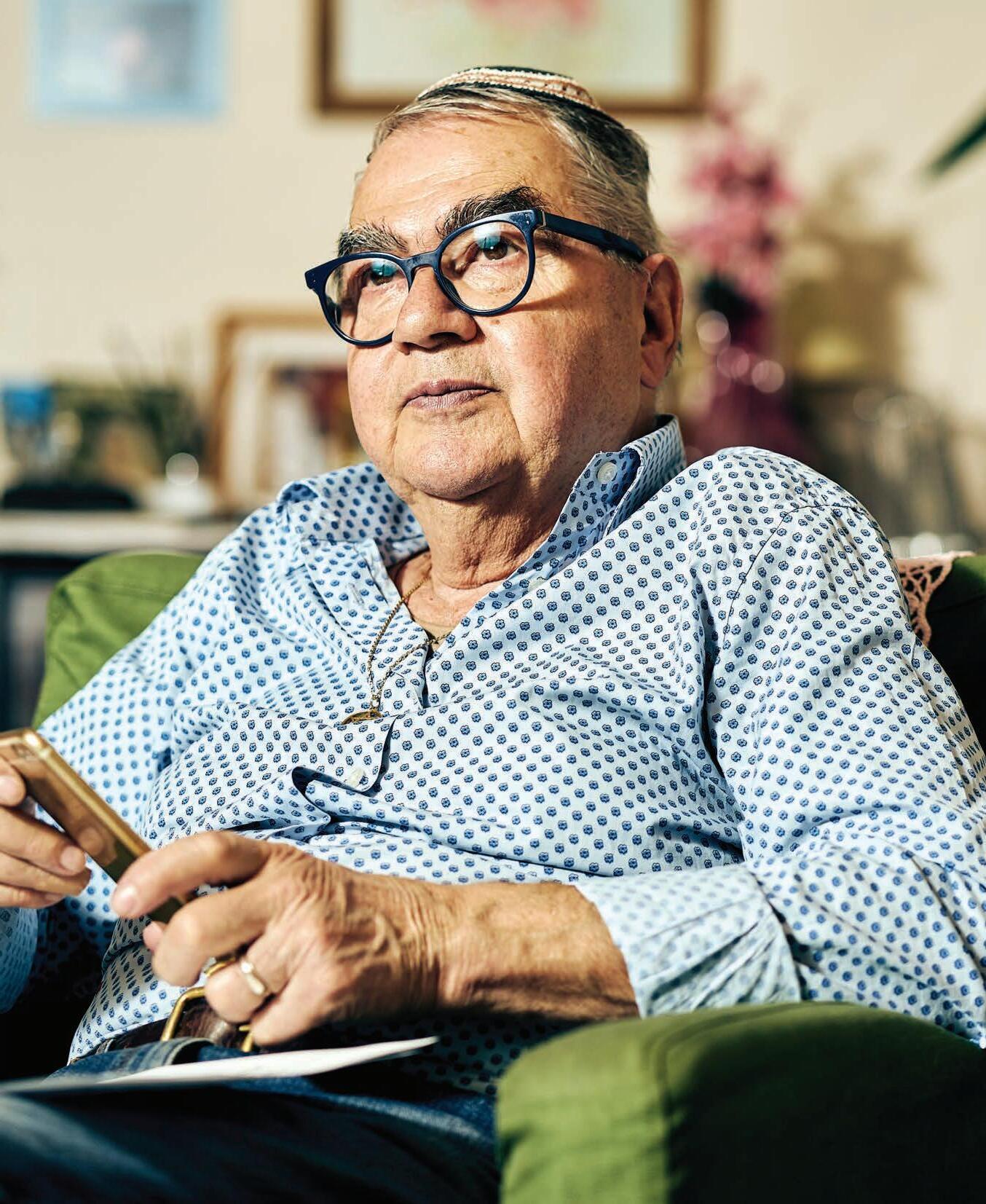
ident Emmanuel Macron to get involved. The lawmakers, who support creating a Palestinian state, have said Israel’s move constitutes a “major rupture in diplomatic ties.”
Israel has banned other anti-Israel politicians from entering, including British parliament members Yuan Yang and Abtisam Mohamed, whom Israeli authorities stopped at Ben Gurion Airport and deported.
Israel’s relationship with France has been deteriorating since Macron suggested France may soon recognize a Palestinian state.

This week, two men were sentenced to seven years in prison for their roles in the 2018 Tzafit riverbed flash flood tragedy in which 10 teens were killed.
Yuval Kahan, the former principal of the Bnei Zion premilitary academy, and Aviv Bardichev, a former teacher at the institution, were also each ordered to pay NIS 210,000 ($57,000) in compensation.
The two were convicted of negligent manslaughter last year. They were held responsible for the deaths of 10 academy and high school students who were in a group that was hit by a flash flood while hiking in the Tzafit riverbed in the Dead Sea region.
The pair was accused of disregarding multiple inclement weather warnings ahead of the trip, insisting on going ahead with the plan and scorning safety concerns. The court said that they should have changed the route of the trip due to the poor weather.
The court noted Kahan’s negligence and said that “despite his senior managerial position and the unusual and extreme situation in which the group was traveling, he was not interested and did not know what exactly the group was doing, and when he did [finally] understand what it was doing, he did not stop it.” Kahan was not with the group at the time of the disaster.
The court said that Bardichev did not give adequate consideration to the warnings he had received “and entered the stream with a group of young people who trusted him, despite those warnings and the prevailing weather” at the time of the disaster.
“The court emphasized the high level of harm to the sanctity of life and other values, including the harm to the trust between parents and educational staff,” in the wake of the disaster.
The 10 victims of the disaster which occurred on April 27, 2018 were: Romi Cohen, Ilan Bar Shalom, Shani Shamir, Adi Raanan, Agam Levy, Yael Sadan, Maayan Barhum, Tzur Alfi, Gali Balali, and Ella Or.
In November, parents of the victims expressed dismay over the Beersheba District Court ruling that cleared Kahan and Bardichev of the more serious offense of negligent homicide that they were originally charged with, instead convicting them of reckless manslaughter.
On Monday, a man was attacked by a shark off the coast of Hadera. By Tuesday, authorities found the body of the 40-year-old father of four from Petach Tikvah.
Police, the Nature and Parks Authority, the Fire and Rescue service, the army, medics, and volunteers were conducting the search of the area for the missing man.
The incident took place in an area of the beach where swimming is not allowed. Bystanders noticed the attack and called for emergency services.
This week’s attack is only the third recorded shark attack in Israel, according to Yigael Ben-Ari, head of the Parks and Nature Authority’s marine ranger force. One person was killed in an attack in the 1940s.
The area near the attack has attracted dozens of sharks for many years between the months of October and May. Warm water released by a nearby power plant flows into the sea, which the sharks enjoy. Swimming is prohibited in the area, but swimmers enter the water anyway.
Videos of people swimming and wading in the water as sharks swim near them have been surfacing.
“What a huge shark!” one man says in a video. “Whoa! He’s coming toward us!”
“Don’t move!” he implores a boy standing nearby, who replies, “I’m leaving.”
The man then asks, “What, are you afraid of the sharks?”
A friend of the person who went missing said that he warned him not to enter the water. “And then, I received the bitter news,” he said.
“We’ve known each other for more than 20 years and hang out together. In another two months, my son is getting married, and I told him, ‘You’ll be the first person I invite. You are my brother.’ He was supposed to travel to Thailand, and I told him to wait, and we’ll go together after the wedding.”
Dusky and sandbar sharks, which frequent the area during the period between November and May, are not known to attack humans.

Former Senator Bob Menendez’s wife, Nadine Menendez, was found guilty this week in New York for her role in a years-long bribery scheme that included stacks of cash, gold bars and a Mercedes-Benz.
Nadine, 58, was found guilty on all 15 counts, including bribery and obstruction of justice, for aiding her husband, Senator Menendez, who received lavish gifts in exchange for political favors.
Nadine had been indicted with her husband in September 2023. Her sentencing is set for June 12.
Bob Menendez was convicted in July 2024 and sentenced to 11 years in prison.
In a statement, the U.S. attorney’s office for the Southern District of New York said the couple were “partners in crime” who participated in “corrupt official acts.”
“Today’s verdict sends the clear message that the power of government officials may not be put up for sale,” the statement said.
During the trial, prosecutors argued that Menendez was an indispensable part of her husband’s bribery scheme, telling the jury it was she who often accepted the cash and other gifts on behalf of the former senator.
Her husband, at the time, was the top-ranking Democrat on the powerful Senate Foreign Relations Committee for more than five years, a position that gave him significant influence over U.S. foreign policy.
“She was keeping him in the loop every step of the way,” Paul M Monteleoni, a prosecutor, said in a closing argument.
Menendez’s lawyers argued that the government failed to prove a link between the gold and stacks of cash found in the couple’s home to any “official act” taken by her husband. The FBI had searched the Menendez home in New Jersey in 2022 and found more than $100,000 worth of gold bars and hundreds of thousands of dollars in cash in envelopes or hidden in clothes.
Fred Daibes, a New Jersey property developer, and Wael Hana, the Egyptian-born operator of a halal certification company, were also charged and convicted for their roles in the bribery scheme.
We all know that walking is good for our health. But now, research suggests that walking briskly may be better for you than strolling down the street.
The study, published this week in the journal Heart, found that average or brisk walking paces were associated with 35% and 43% lower risks of all heart rhythm abnormalities studied, respectively, compared with a slow pace. Those abnormalities are the arrhythmias: atrial fibrillation, bradyarrhythmias and ventricular arrhythmias. Atrial fibrillation, or A-fib, is the most common arrhythmia, characterized by an irregular and rapid heartbeat beginning in the upper chambers, or atria, of the heart. Bradyarrhythmias are abnormally slow heart rates of typically below 60 beats per minute, compared with the normal range of 60 to 100 beats per minute. Ventricular arrhythmias occur when the lower chambers of the heart, or ventricles, beat too fast.
“The great thing about walking is that it is accessible to everyone,” noted senior study author Dr. Jill Pell, the Henry

Mechan Professor of Public Health at the University of Glasgow in Scotland. “You don’t need to spend money going to a gym or buying equipment. You can just walk out of your front door and keep going.”
Nearly 60 million people worldwide have atrial fibrillation, according to a 2024 study. Estimates of people with other arrhythmias are less conclusive, but in general, people with arrhythmias are at higher risk of having heart attacks or strokes and dying early, Pell said.
“There are medicines and procedures that can be offered to these people but it would be preferable to prevent heart rhythm abnormalities from occurring in the first place,” Pell added.
The authors studied health and activity data from adults who had been recruited between 2006 and 2010 for the UK Biobank study, which followed the health outcomes of more than 500,000 people between the ages 40 and 69 in the United Kingdom. Participants answered questionnaires that asked whether their walking pace was slow (less than 3 miles or 4.8 kilometers per hour), average (3 to 4 miles or 4.8 to 6.4 kilometers per hour) or brisk (more than 4 miles or 6.4 kilometers per hour).
During a follow-up period of 13 years on average, 9% of participants developed arrhythmias.
“The data from the watches showed that walking at an average pace (3-4 miles per hour) for only 5-15 minutes per day was sufficient to reduce your risk,” Pell said.
The associations were strongest among people under 60, people without obesity, those with high blood pressure or two or more preexisting conditions, and women, the authors found.
“This is an interesting finding because, although women are less likely to get atrial fibrillation than men, when they do get it they are at a higher risk of going on to get heart attacks and strokes than men with atrial fibrillation,” Pell said.
On Friday, Capital One received permission to move forward with its $35 billion acquisition of Discover, a credit card company. Regulators are allowing Capital One, the banking company, to acquire Discover as long as certain pending enforcement actions against the credit card company are resolved.
If successful, the merger would greatly help Capital One, which would then be worth over $650 billion in assets.

Capital One stated that it believes the deal’s outcome will be determined in May. The Federal Reserve stated that the merger can happen if Capital One goes along with a consent order with Discover by the Fed and the Federal Deposit Insurance Corp, including hefty fines.
“Discover has previewed these orders publicly for several quarters, and they are fully reserved for the fines and restitution,” Capital One stated, adding that Discover “has reached these agreements to address the remaining government inquiries.”
Discover has faced a few major challenges. The company, in 2023, admitted to having incorrectly classified credit card accounts since 2007, placing them into the highest pricing tier.
What’s in your wallet?

On the first night of Passover, following the meal held at Pennsylvania Gov. Josh Shapiro’s home, the governor’s house was burned down in an arson attack, forcing him and his sleeping family to evacuate. On Friday, ABC News’ George Stephanopoulos interviewed the Jewish governor while taking a tour of the destroyed house.
The perpetrator scaled a fence, carrying with him “a bag that contained some Molotov cocktails and had a metal type of hammer,” Shapiro explained. The individual then hid in the bushes near the fence. When he mistakenly activated security sensors, a state trooper arrived. However, since it was very late,
the trooper couldn’t find the intruder. Then, the intruder broke one of Shapiro’s windows and hurled a Molotov cocktail into the house, thus setting off “a fire and explosion,” Shapiro shared.
“Just hours before, Lori and I were seated probably right about here, at a long table, conducting our Passover Seder. Three of our four kids were here; the other was in college,” he told Stephanopoulos. “I’m getting emotional just thinking about it — we had our family, we had guests from the community from across Pennsylvania. It was just a really beautiful night.”
Shapiro, his family, and guests continued the Passover meal until around midnight. An hour later, the family went to bed, and at around 2 a.m., the arson attack took place.
Although the suspect said he attacked Shapiro’s home because of the governor’s pro-Israel views, Shapiro has yet to declare the attack a hate crime or an act of domestic terror. Instead, he maintains that it isn’t his, but rather the prosecutors’, duty to classify the crime.
Shapiro said that Attorney General Pam Bondi and FBI Director Kash Patel contacted him “immediately” after the attack.
Stephanopoulos also asked Shapiro what we must do to “combat this kind of hate” and antisemitism.
“By speaking and acting with moral clarity. Let me explain,” said Shapiro. “Immediately following the assassination attempt on the former president – now-president – in Butler, Pennsylvania, I condemned that in the strongest of terms. I spoke to the victims, I went to Butler. When the assassin who killed the U.S. healthcare CEO was caught in Altoona, Pennsylvania, I immediately went there and condemned that kind of violence in clear terms.”

On December 4, 2024, Luigi Mangione allegedly shot and killed Brian Thompson, the CEO of UnitedHealthcare, in Midtown Manhattan right
outside the hotel Thompson had just exited. Five days after the murder, Mangione was found and detained in Altoona, Pennsylvania.
Now, a federal grand jury in New York has indicted Mangione on four counts: two stalking offenses, one firearms offense, and one count of murder through the use of a firearm. If he’s convicted, he could potentially be sentenced to death. Attorney General Pam Bondi has said she would seek the death penalty for Mangione in order to “carry out President Trump’s agenda to stop violent crime and Make America Safe Again.”
Last week, Karen Friedman Agnifilo, a defense attorney, filed a motion shortly before Mangione was indicted, accusing prosecutors of acting in an inappropriate way that “prejudiced the grand jury process.” She requested that the judge exclude Mangione from the possibility of capital punishment, and she ordered the government to hand in documents and notes relevant to the attorney general’s directive. Mangione’s defense has argued that “the United States government intends to kill Mr. Mangione as a political stunt.” Additionally, states have also charged Mangione, although he has pleaded not guilty.
Mangione had been found in a McDonald’s in Altoona, Pennsylvania, days after he murdered Thompson. A customer had alerted an employee who called police. Officers questioned Mangione, who they described as acting suspiciously.
Mangione was carrying multiple fraudulent IDs and a U.S. passport along with several weapons. One of the IDs matched the fake New Jersey ID that the shooting suspect used to check into a Manhattan hostel before the shooting.
A three-page handwritten document that “speaks to both his motivation and mindset” was also recovered from Mangione when he was apprehended by police. Mangione had written that the U.S. had “most expensive healthcare system in the world” but lamented that the country “ranks #42 in life expectancy,” according to NYPD sources.
Mangione also referred to corporations as “mafiosa [that] have gotten too powerful,” and said such companies abuse the United States “for immense profit.” He wrote that others had shone a light on corporations’ “corruption and greed” in the past and claimed that he was “the first to face it with such brutal honesty.” He was not a customer of UnitedHealthcare.





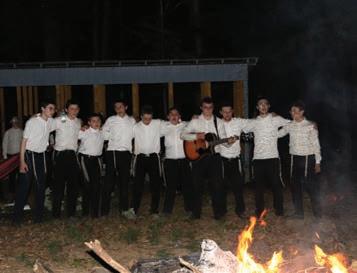

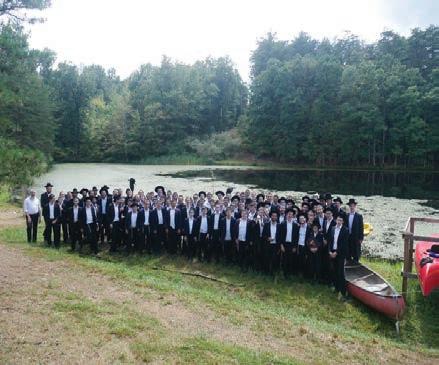




On Friday, April 11, the Trump administration sent Harvard University a letter, demanding that the school change its curriculum, hiring, and admissions practices. The letter shocked Harvard since it came just when it seemed like the White House and the university were reaching an agreement on tackling rampant campus antisemitism. Thus, that following Monday, Harvard vowed publicly to resist President Donald Trump, escalating the university’s fight with the president. Trump went on to freeze federal funding and threaten the university’s tax-exempt status.
Now, it seems that the letter was sent in error. According to reports, Josh Gruenbaum, a lawyer for the Trump administration and top official at the General Services Administration, contacted Harvard soon after the university rejected Trump’s demands. Gruenbaum told Harvard’s lawyers that he and Thomas Wheeler, the Department of Education’s acting general counsel, hadn’t authorized the email. Gruenbaum later suggested that the email was, in fact, meant to be sent but at a later date.
Harvard rejected the notion that it should have contacted the White House’s lawyers before responding publicly to the letter.
The letter “was signed by three feder-
al officials, placed on official letterhead, was sent from the email inbox of a senior federal official and was sent on April 11 as promised,” the university stated. “Recipients of such correspondence from the U.S. government — even when it contains sweeping demands that are astonishing in their overreach — do not question its authenticity or seriousness.”
“It remains unclear to us exactly what, among the government’s recent words and deeds, were mistakes or what the government actually meant to do and say. But even if the letter was a mistake, the actions the government took this week have real-life consequences.”
Though the letter was not authorized to be sent on Friday, the Trump administration has chosen not to withdraw it. Instead, the fight between Harvard and Trump has only escalated, as the president has begun threatening the Ivy League college for publicly resisting his requests.

House Democrats traveled to El Salvador on Monday to press for the release of a Maryland resident who was mistakenly deported there last month and to demand updates on him and other migrants who are imprisoned there.
The visit was the latest bid by Democrats in Congress to amplify the case of Kilmar Abrego Garcia, a Salvadoran man

whom Trump administration officials have admitted to erroneously sending back to his home country, and hundreds of other immigrants the administration has hastily deported.
Reps. Robert Garcia of California, Maxwell Alejandro Frost of Florida, Yassamin Ansari of Arizona and Maxine E. Dexter of Oregon met with William H. Duncan, the U.S. ambassador to El Salvador, at the embassy in San Salvador on Monday morning. They urged the ambassador to raise the issue with Salvadoran officials and to press for transparency about Abrego Garcia’s detention.
The lawmakers said they had not been permitted by Salvadoran officials to meet with Abrego Garcia.
After their meeting, a U.S. Embassy official said the lawmakers’ concerns had been relayed to the Salvadoran government.
The official said it was the first time the embassy had raised questions to President Nayib Bukele’s administration about the treatment of more than 250 Venezuelan migrants now being held in Salvadoran custody.
At a news conference after the meeting, the Democrats denounced the Trump administration’s failure to comply with court orders, including a Supreme Court decision instructing the administration to take steps to facilitate Abrego Garcia’s return to the United States.
“We left that meeting with absolutely zero indication that this administration is going to facilitate, or wants to facilitate, the return of Abrego Garcia back to the United States so he can go through due process,” Frost told reporters.
The lawmakers’ visit follows that of Sen. Chris Van Hollen, D-Md., who traveled to El Salvador last week. After two days of resistance from Bukele’s government, Salvadoran officials allowed Van Hollen to meet with Abrego Garcia face-to-face, delivering him unexpectedly to the senator’s hotel for a meeting that appeared staged to emphasize how well he was being treated.
(© The New York Times)
Walgreens has agreed to pay up to $350 million in a settlement with the U.S. Department of Justice, who accused the pharmacy of illegally filling millions of prescriptions in the last decade for
opioids and other controlled substances.
The nationwide drugstore chain must pay the government at least $300 million and will owe another $50 million if the company is sold, merged or transferred before 2032, according to the settlement reached last Friday.
According to the complaint filed in January in the U.S. District Court for the Northern District of Illinois, Walgreens knowingly filled millions of illegal prescriptions for controlled substances between August 2012 and March 2023. These include prescriptions for excessive opioids and prescriptions filled significantly early.

“We strongly disagree with the government’s legal theory and admit no liability,” Walgreens spokesperson Fraser Engerman said in a statement. “This resolution allows us to close all opioid related litigation with federal, state, and local governments and provides us with favorable terms from a cashflow perspective while we focus on our turnaround strategy.”
The complaint says Walgreens pharmacists filled these prescriptions despite clear red flags that the prescriptions were highly likely to be invalid, and the company pressured its pharmacists to fill them quickly. The government alleges Walgreen’s compliance officials ignored “substantial evidence” that its stores were filling unlawful prescriptions and withheld important information on opioid prescribers from its pharmacists.
Walgreens then allegedly sought payment for many of the invalid prescriptions through Medicare and other federal healthcare programs in violation of the False Claims Act, according to the government.
The U.S. Justice Department has moved to dismiss its complaint in light of Friday’s settlement.
“Pharmacies have a legal responsibility to prescribe controlled substances in a safe and professional manner, not dispense dangerous drugs just for profit,” said Attorney General Pamela Bondi in a statement. “This Department of Justice is committed to ending the

opioid crisis and holding bad actors accountable for their failure to protect patients from addiction.”
The settlement resolves four cases brought by former Walgreens employee whistleblowers. In 2022, CVS and Walgreens agreed to pay more than $10 billion in a multi-state settlement of lawsuits brought against them over the toll of the opioid crisis.
Over the past eight years, drugmakers, wholesalers and pharmacies have agreed to more than $50 billion worth of settlements with governments — with most of the money required to be used to fight the opioid crisis
This week, U.S. Health and Human Services announced that it will phase out the remaining eight artificial food dyes from America’s food supply within two years.
This initiative will target artificial dyes that are used in cereal, ice cream, snacks, yogurts and more.
The Biden administration in January started the process to ban one artificial dye, Red No. 3, which will need to be removed from food by January 2027 and from medications by 2028 because it was shown to cause cancer in rats.
Secretary Robert F. Kennedy Jr. will now seek to remove the eight other petroleum-based dyes approved by the FDA. He is expected to announce the approval of additional natural dyes.
Synthetic food dyes are found in a wide range of products that Americans consume including candy, cereal, and medication. Studies suggest their vibrant color makes food more appealing and could even increase appetite. But the health effects of the dyes are concerning, and many other countries have either banned the additives outright or require food packaging warning labels about the health risks.
Certain states have banned some dyes. West Virginia and California have passed laws to ban a handful of food dyes from school lunches, with plans to extend the ban to a broader, statewide level. In West Virginia, the ban on artificial dyes in school lunch will go into effect in August, making it the first state in the country to implement such restraints. In California, it will take effect in 2028.
When Don Pettit landed in Kazakhstan from a whirlwind seven-month mission in space, he landed with a bang. NASA’s oldest serving astronaut came back to Earth on his 70th birthday.
The Soyuz capsule carrying Pettit, who is American, and two Russian cosmonauts landed on Sunday morning, hours after undocking from the International Space Station.

Pettit and his crew mates, Alexey Ovchinin and Ivan Vagner, spent 220 days in space, orbiting the Earth 3,520 times and completing a journey of 93.3 million miles over the course of their mission.
It was Pettit’s fourth space flight, with the astronaut now having logged more than 18 months in orbit throughout his 29-year career.
Despite turning 70 as the mission ended, Pettit is not the oldest person to fly in orbit. In 1998, John Glenn flew on a NASA mission at the age of 77.
After the group landed, NASA said that Pettit was “doing well and in the range of what is expected for him following return to Earth.”
He is expected to travel to the Kazakh city of Karaganda and spend some time readjusting to gravity before boarding a NASA plane to the agency’s Johnson Space Center in Texas. His Russian crewmates will end up in Russia’s space training base near Moscow.
Pettit spent his time on the ISS researching water sanitization technology, 3D printing capabilities, plant growth in various conditions and fire behavior in microgravity.
No wonder he’s so excited to have reached this milestone birthday.
Why hire a moving company when you have customers who will do it for you?
Michelle Tuplin, the owner of Serendipity Books in Chelsea, Michigan, was
moving her store to a larger facility down the block. There were 9,100 pieces of inventory – books – that needed to be moved 350 feet. So Tuplin did what every frugal storeowner would love to do: she put out a call for volunteers to help move the heavy tomes.
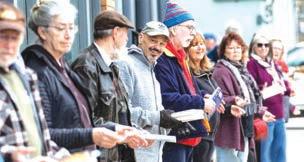
More than 300 people – and a dog – convened and formed the “book brigade,” essentially a human chain in which books were passed one at a time in alphabetical order.
“People really consider independent bookstores theirs,” Tuplin explained. “It’s really a part of the community, and they have ownership.”
It took less than two hours for all the books to find their new home.
Loyal readers from all ages came to help.
“There was a 91-year-old woman. There was a good customer who has issues with his heart. There was somebody with their 6-year-old child. And we figured if we just did it book by book, everybody could be involved,” Tuplin said.
“To see the community come out and, you know, put all those words that they say, usually say, into action, it truly just meant the world,” Tuplin said. “It was overwhelming.”
Sounds like they did it by the book.
A half-marathon held in Beijing, China, on Saturday included runners who barely broke a sweat.

Thousands of “humanoid” robots ran alongside actual humans in the race.
The bipedal robots of various makes and sizes navigated the 13.1-mile course supported by teams of human navigators, operators, and engineers, in what event organizers say was a first. A divider separated the parallel courses used by the robots and people.
The people followed conventional
rules for the half-marathon. The robots had tailored guidelines, including battery swap pit stops. Awards were given out to the robots for best endurance, best gait design and most innovative form.
One robot, the Sky Project Ultra robot, also known as Tien Kung Ultra, from the Tien Kung Team, claimed half-marathon victory among the non-humans, crossing the finish line in 2 hours, 40 minutes and 42 seconds.
Racing against the clock…

The tiny Pacific island nation of Tuvalu can finally cash out. The country unveiled its first-ever ATM in a move hailed as momentous by the prime minister. The installment of the cash machines is the first time that the island’s 11,000 inhabitants have had access to electronic banking.
Five machines and 30 sale terminals have been installed on Funafuti, the country’s main island, including at its airport.
Feleti Teo, the prime minister, said the move “not only marks a momentous occasion but it is also historic as the bank moves into a totally new era.”
“We’ve been in an analog space all along, these were dreams for us,” Teo said according to the Guardian.
“These machines don’t come cheap. But with government support and sheer determination, we were able to roll out this service for our people.”
The ceremony for the ATMs took place at the headquarters of the National Bank of Tuvalu in the village of Vaiaku on Funafuti. It was also attended by traditional leaders, members of parliament and business officials. A large cake was on display for the celebration.
Tuvalu is a group of nine small islands in the South Pacific which won independence from the United Kingdom in 1978. Before this week, people in Tuvalu had to line up at the bank to get money.
In addition to getting their cash from the machines, stores will also be able to process electronic payments for the first time.
Cash and carry.
W E D D I N G P A C K A G E


By Rabbi Zvi Teichman
We are about to conclude the marvelous month of Nissan with all the warm memories of our recent Pesach experience, from arduous prep to inspired conclusion, that will carry and inspire us through the year.
In one of the marvelous piyyutim that are added to the Yotzros of Parshas HaChodesh, that were said in many Shuls a month ago, we read the following stanza:
— His Footstool that was laid low and plowed under may it be renewed on this day in greater measure than ever,
— an we shall deliver a gift to the Sanctuary, on the first day of this first month.
The ‘footstool’ refers to the Temple.
Yeshayahu the prophet relays how G-d states, “The heavens are My throne, and the earth is My םודה — footstool, which is the house that you will build for Me… (66 1)
I have always wondered what deeper meaning is conveyed in describing the Temple as a ‘footstool’. Does G-d need to kick His feet up and rest them upon a hassock?
We read this week of the well-intentioned sons of Aharon, Nadav and Avihu, who at the peak of the inauguration ritual brought with great zeal an alien fire they were not commanded to and lost their lives.
The Torah tells us that these seemingly tragic deaths were a fulfillment of a prior Divine statement that declared שדקא
— I will be sanctified through those who are nearest to Me.
Rashi, quoting from the Midrash, clarifies that this wasn’t simply a classic sanctification of G-d’s name, after all they didn’t expect to die. There was no sacrificing of themselves willingly as in the many examples — in the image of Avraham Avinu — of people who went happily to their deaths for the sake of G-d.
It was rather that through their deaths תיבה שדקתי — that this House was to be sanctified.
Rashi adds that the glory that comes from their deaths is due to the reaction of those who will observe how ‘when the Holy One, blessed is he, exacts judgment upon the righteous, He becomes feared, exalted, and praised. Now, if this is so concerning the righteous, how much more is it so concerning the wicked.’
Somehow the realization of man’s accountability for all one’s imperfect actions, no matter how great and worthy that individual may be, instills a fear for repercussions for those of us who sin regularly. This, as Rashi says, is the first reaction — fear.
But how does fear prod us to exalt and ultimately praise G-d?
Do the wicked react with awe? Didn’t so many who experienced the Holocaust question the seeming injustices of so many holy and innocent souls perishing under the cruelty of their enemy. How could a benevolent G-d have allowed that to happen?
Rebbe Boruch of Kamarna who accepted the mantle of leadership after his father Rebbe Shalom passed, refused to abandon his flock during the war years — despite being provided means of escape by his loyal followers — and perished with his family at the age of twenty-eight.
He would interpret the words of G-d that were stated regarding the deaths of Nadav and Avihu in the following insightful manner: שדקא יבורקב — For those who are close to G-d and fathom the deeper understanding of the deaths of Nadav and Avihu, to them My name will be sanctified. However, ינפ לעו — to those faces, םעה לכ — of the simple folk who cannot fathom and justify G-d’s ways, דבכא — It will be too heavy of a load to explain.
Those who see a system of accountability as evidence of G-d’s desire to bring us to greatness and perfection, will initially fear their poor standing before G-d and worry about their fate. Upon
their contemplation they will be stirred to rise to their calling, knowing that it isn’t a vengeful G-d extracting punishment, but an exalted G-d who is pushing us for our benefit and pleasure. Finally, we will come to the realization of how fortunate and privileged we are to have such a magnificent relationship with Him.
What determines whether we are of those closest to Him or of the simple folk who feel weighted down by the apparent inconsistencies in G-d’s dispensing of judgment, is if we possess the art of knowing how to experience life.
The great Mashgiach, Rav Shlomo Wolbe, describes people who see and hear things that are earth shattering experiences but are not moved. They have a need to talk, label, evaluate, immediately judge whether it is good, nice, or worthy. They do not absorb what is going on. They have not mastered the art of silence.
Someone who can be silent, can sit in solitude with oneself. Not only ‘can’ one sit silently, but one comes to cherish that moment. The ability to separate oneself, and face oneself, is evidence of someone who seeks the spiritual. One relishes the quiet moments of self-discovery and exploration of self.
It was Aharon who in a moment of tragedy so masterfully traveled — in silence — from fear of G-d, to sensing His exalted devotion to His flock, and ultimately express praise to the Almighty for His infinite wisdom and perfect direction.
Reb Nachman of Breslov cites a connection between the םודיו — ‘silence’ of Aharon, and םודה — the ‘footstool’ of G-d.
The metaphor of G-d sitting upon His throne in Heaven and placing His feet upon the earth in general — and more specifically within the Temple when it stood — represents the relaxed absolute control of His presence on earth as reflected, יבורקב — in those nearest to Him, who experience life through the prism of the contemplative lens of Torah and its commands.
Esav, the antithesis of Yaakov, sells the birthright on the day he hears of the death of Avraham, blurting out his frustration querying how it could be that the measure of judgment can affect a personage as holy and righteous as Avraham. It was at that moment he rejected it all because he simply couldn’t face the folly of his own being.
The Divine Presence descended into the Tabernacle — and in its absence — within each one of us. When we can live with ourselves, we will give ‘respite’ to G-d, allowing him to ‘rest’ while we become the living embodiment of His Presence in this world.
Julie Kuperstein, whose son Bar was taken hostage on that fateful SimchasTorah and remains in captivity, has been an inspiration. With her unshaking faith she has initiated many projects to increase the merits for her son and all the hostages. In her own words, “G-d has presented me with a challenge, and the strength to endure.”
During an interview she shared the following remarkable anecdote.
Some time ago she received a phone call from an individual speaking with a heavy Arab accent. “Your son is in our hands”, he began, “and you aren’t doing enough to free him”. She was terrified. Her heart fell from fear. She recited a silent prayer that Hashem should place the right words in her mouth. She asked the terrorist, “What do you mean, I’m not doing enough?” “You must go out and protest until your government collapses”, he responded, “otherwise your son will remain in ‘my hands’.” After a moment of silence, not knowing what to say, or from where she would find the strength, she remained calm not permitting herself to get confused, and responded, “My child is not in ‘your hands’, he is in the hands of G-d, and you should know that you too are in G-d’s hands, and only what He so desires will be what happens!”
There was a deep silence on the other end, he had to digest the fact that his psychological terror wouldn’t faze her. And then suddenly he said, “Kol HaKavod Geveret — Bravo Mrs.!”, abruptly hanging up.
There are people who possess the ‘art of silence’, the ability to transform initial fear into a remarkable expression of faith and praise to our Father in Heaven.
May our being inspired in kind be an added merit for the release of the hostages soon.
שדקא יבורקב — I will be sanctified through those who are nearest to Me!
You may reach the author at: Ravzt@ ohelmoshebaltimore.com
The climax of the inauguration period was on the 8 day, on the first day of Nissan, when the Tabernacle was erected and Aaron and his sons were consecrated for their new service. Thus, the priestly service began! At the peak of the inauguration ritual, tragedy struck and Nadav and Avihu died. Commandment to Aaron against intoxicants. The laws of Kashrus are given to the Jewish people.
“Good leaders create followers, but great leaders create leaders.”
Inspiration Everywhere


Rabbi Lord J. Sacks zt”l
The numerical value of ינימש , the name of the parsha, is 410, which is the same as שודק - holiness.
In the realm of numbers, the number ינימש - or 8 - represents holiness, as it is one more than seven, which is nature. During the days of Sefiras HaOmer, we count 7 weeks, until the 50 day (week 8!), where we celebrate the holiness of Shavuos! th


Rabbi Ori Strum is the author of “Ready. Set. Grow.” “Dove Tales,” and “Karpas: The Big Dipper.”
His shiurim and other Jewish content can be found on Torah Anytime and Meaningful Minute.
You can reach him at 443-938-0822 or oristrum@torahsparks.com
PARSHA STATS
Pesukim - 91
Words - 1,238
Letters - 4,670
Mitzvos - 17
The Alter Rebbe, in his Sefer HaTanya, says that the idea of
The extensive list of the Jewish dietary laws can be found in this week’s Parshah, Shemini.
At the end of the day, the deeper symbolism of Kashrus can boil down to the passuk: םשדקתהו
- AND YOU SHALL BE HOLY!!!
We have a separate diet than the rest of the world because we are inherently and fundamentally different than the rest of the world. We are in the realm of םישודק , holy and precious.
Rashi (Vayikra 18) says that when a ןב ךלמ (son of a king) eats regular (common-people) food, he throws up. That’s because his body is used to royalty.
The same idea, perhaps, is true when it comes to Kashrus. We are the children of Hashem, the King of the Universe. As such, our spiritual and physical diet must not be that of the common people. We cannot tolerate consuming that which is not royalty. We have higher standards because we are so holy.
- you shall sanctify yourselves and be holymeans that a person who sanctifies himself only a little below, will become santified in great measure from Above!
We are meant to do what we are able to do, and when we do that, Hashem will take care of the rest!
This week is הלח לסילש, or “Key Challah.” There is a powerful minhag to place a key inside the challah (or make the challah into shape of a key, etc) on the Shabbos after Pesach.
What is the deeper reasoning? What does this symbolize?

Let’s try to remember this!

Scan the QR code to view Torah classes from R’ Ori Strum on Torah Anytime!


It seems like a lot longer ago than just eight months since then-Vice President Kamala Harris tapped Minnesota Gov. Tim Walz to be her running mate. Picking the inept Walz to stand beside her on the Democratic presidential ticket was one of a series of blunders that led to her being defeated by President Donald Trump in November. Indeed, so tone deaf was her campaign to the national mood that it is highly likely that she would have lost even if she had not passed over the far more politically adept Pennsylvania Gov. Josh Shapiro in favor of Walz.
The arson attack by a person who claimed his motive was support for the Palestinians in their war against Israel on the governor’s mansion in Harrisburg is a brutal reminder of why Shapiro didn’t get a chance to help prop up Harris’s doomed campaign.
Shapiro was a far more impressive candidate than Walz turned out to be. He certainly would have fared better than Walz in the vice-presidential debate against then-Sen. JD Vance (R-Ohio). He also might have potentially helped flip Pennsylvania into the Democratic column. Instead, Trump won the commonwealth’s 19 Electoral College votes by a relatively slim but decisive 120,000 votes. Though he was as liberal as Walz on most issues, Harris picked the Minnesotan. The main reason was the widely held perception that Shapiro’s Jewish identity was disqualifying for many in her party’s left-wing base that reviles Israel.
In the end, neither that foolish decision nor a year’s worth of kowtowing to campus antisemites and American Muslim supporters of Hamas was enough to help Harris engender much enthusiasm from the intersectional activist wing of the Democratic Party, as
By Jonathan S. Tobin

working-class voters of all races turned out to help elect Trump and Vance.
Yet, as the Democratic Party rallies to the defense of elite universities being threatened with defunding by Trump because they refuse to stop tolerating and encouraging antisemitism, Jew-hatred remains a problem for Shapiro’s party.
Antisemitism on the Left
The arsonist, who reportedly also brought along a hammer with which he said he planned to assault the governor had he met him, was mentally unstable and had a criminal history. Yet much like the way mobs chanting for Israel’s destruction (“From the river to the sea”) and terrorism (“Globalize the intifada”) have normalized intimidation and violence against Jews, his ravings about “the Palestinian people” and opposition to Israel’s war against Hamas illustrate the impact of the lies being spread about a “genocide” being committed in Gaza.
It goes without saying that had someone who was a Trump supporter committed such an attack, the liberal corporate media would have tied the crime to the president, and it would have remained a top story for weeks, if not months. Instead, the press is quickly moving on from the attempt to murder the Pennsylvania governor, and there are no op-eds in The New York Times or The Washington Post claiming that left-wing Democrats have, at the very least, created an atmosphere in which such violence has become imaginable.
Of course, that’s exactly what Democrats and much of the press were saying in October 2018 when a crazed gunman, who blamed liberal Jewish groups for illegal immigration but also despised Trump because of his support for Israel, attacked a Pittsburgh synagogue and murdered 11 Jewish worshippers at a Shabbat service. Indeed, Shapiro himself, then the Attorney General of Pennsylvania, was saying much the
same thing himself when he was dropping hints about blaming Trump in the wake of that atrocity.
Shapiro and Muslims
That Shapiro has become an object of such suspicion and distaste for the left is ironic. When it comes to Israel, he is typical of most liberal Democratic officeholders. He was an early and enthusiastic supporter of President Barack Obama and never wavered from that position during that administration’s eight years of criticism of Israel and appeasement of Iran. He has attacked Israeli Prime Minister Benjamin Netanyahu as “one of the worst leaders of all time.”
On Israel and the war in Gaza, he is far to the left of fellow Pennsylvania Democrat Sen. John Fetterman. Shapiro has also been actively trying to build bridges to the anti-Israel left. During the brief period when he was under consideration for the vice-presidential nomination, he disavowed two entirely reasonable op-eds he had written when he was a student because they stated the obvious truth that peace between Israel and the Palestinians was “virtually impossible.”
And just days before the arson attack on his home, the governor was being criticized by some in the Jewish community for his decision to give a $5 million state grant to a Philadelphia mosque— the largest-ever to a Pennsylvania-based Muslim institution—that is notorious as a hotbed of antisemitism. In doing so, Shapiro was sticking to the left’s disingenuous argument that a mythical wave of Islamophobia was morally equivalent to the unprecedented surge of antisemitism that has arisen since the Hamas-led attacks on southern Israel on Oct. 2023 ,7 . The decision was announced when Shapiro attended
an Iftar dinner at the mosque, where he said the taxpayer funding of the expansion of the Al-Aqsa Islamic Society was a response to what he described as “tumult overseas,” adding that “we’re facing a lot of rising hate here at home.”
Yet none of that has exempted Shapiro from being the object of hatred from the left. The only reason why he is disliked by his party’s left-wing base—and considered “egregiously bad on Palestine” by The New Republic and Slate is because of his open embrace of his Jewish identity and refusal to completely disavow any support for Israel in the manner of far-left Jewish politicians like Sen. Bernie Sanders (I-Vt).
This raises serious questions about more than Shapiro’s political future.
Shapiro is one of those Democrats obviously vying for the leadership of his party’s centrist wing. In his case, moderation is more a matter of tone than policy, as demonstrated last July by his graceful reaction to the attempted assassination of President Trump in
Butler, Pa. He remains very popular in Pennsylvania, something that will likely be boosted by the sympathy for him and his family after the arson attack. A highly-skilled politician, he is regarded as a heavy favorite for re-election in 2026 and is already on the short list of the most serious contenders for his party’s presidential nomination in 2028.
want leaders who are willing to wage war on Trump and the Republicans, rather than at least trying to appear to want to unify the country, as Shapiro does.
In the aftermath of Oct. 7, the vilification of nominally pro-Israel Jews, even Obama-supporting liberals like the Pennsylvania governor, has been nor -
His ravings about “the Palestinian people” and opposition to Israel’s war against Hamas illustrate the impact of the lies being spread about a “genocide” being committed in Gaza.
But it remains to be seen how he will ultimately fare in a party in which radical Israel-bashers like Rep. Alexandria Ocasio-Cortez (D-N.Y.), who is inheriting Sanders’s position as putative leader of the left, seems to best represent the sentiments of Democrats. They clearly


malized by the political left on college campuses and in the media. This has created an atmosphere in which Jewish public figures who do not disavow Israel are anathema to the Democrats’ intersectional base.
More than that, it also proves that
antisemitism isn’t, as Democrats have long asserted, solely a phenomenon of the extremist right. Rooted in “progressive” orthodoxies like critical race theory, intersectionality and settler-colonialism, it is now primarily a feature of mainstream political discourse on the left. So strong is the hold of these toxic ideas that it has gotten to the point where liberal institutions like Harvard University would rather forgo $9 billion in federal funds rather than adhere to the Trump administration’s attempt to roll back the tide of woke Jew-hatred.
That has not only isolated liberal Jews who have realized that longtime allies in other minority communities have largely abandoned them and institutions where they once felt at home are now hostile environments. It has created exactly the kind of atmosphere in which Jews of all sorts, whether on college campuses or even in the Pennsylvania governor’s mansion, cannot consider themselves entirely safe.









Mercaz Torah U’Tefillah: EVERY 15 MINUTES
M-F: 6:15 AM, S-F: 6:30 AM, 6:45 AM, 7:00 AM, 7:15 AM, 7:30 AM, 7:45 AM, 8:00 AM, 8:15 AM, 8:30 AM, 8:45 AM, 9:00AM, 9:15AM, 9:30AM, 9:45AM, 10:00AM
Neitz Beit Yaakov [Sefaradi] M-F
Ohel Yakov S-F
6:00 AM Shomrei Emunah Congregation M-F
6:10 AM Agudath Israel of Baltimore M, Th
6:15 AM Kol Torah M, TH
Shearith Israel Congregation M, TH
The Adas: Chofetz Chaim Adas Bnei Israel M, TH
6:20 AM Agudah of Greenspring M, TH
Agudath Israel of Baltimore S, T, W, F
Arugas HaBosem (Rabbi Taub's) S-F
Bnai Jacob Shaarei Zion Congregation M-F
Kehilath B'nai Torah M, TH
Pikesville Jewish CongregationM, TH
Shomrei Emunah Congregation S, M, TH
6:25 AM The Adas: Chofetz Chaim Adas Bnei Israel T, W, F
6:30 AM Agudah of Greenspring T, W, F
Chabad of Park Heights M-F
Darchei Tzedek M-F
Kehilath B'nai Torah T, W, F
Khal Bais Nosson M-F
Khal Ahavas Yisroel/ Tzemach Tzedek M-F
Kol Torah T, W, F
Ohr Yisroel M-F
Pikesville Jewish CongregationT, W, F
Shearith Israel Congregation T, W, F
Shomrei Emunah Congregation T, W, F
6:35 AM Aish Kodesh (downstairs Minyan) M, TH
Ohel Moshe M, TH
6:40 AM Aish Kodesh (downstairs Minyan) T, W, F
Bnai Jacob Shaarei Zion Congregation M, TH
6:45 AM B”H and Mesivta of Baltimore (Dirshu Minyan) S-F
Beth Abraham M, TH
Greenspring Sephardic Synagogue M-F
Ner Tamid M-F
Ohel Moshe T, W, F
Suburban Orthodox Congregation Toras Chaim M-F
6:50 AM Agudath Israel of Baltimore M, TH
Ahavat Shalom [Sefaradi] M, TH
Bais Medrash of Ranchleigh M, TH
Bnai Jacob Shaarei Zion Congregation T, W, F
Community Kollel Tiferes Moshe Aryeh M, TH
Derech Chaim M-F
Kol Torah M-F
Ohel Moshe S
Ohr Hamizrach [Sefaradi] M, TH
Shomrei Emunah Congregation M, TH
The Shul at the Lubavitch Center M, TH
6:55 AM Beth Abraham T, W, F
Kol Torah M, TH
7:00 AM Aish Kodesh (upstairs Minyan) M-F
Agudath Israel of Baltimore S, T, W, F
Ahavat Shalom [Sefaradi] T, W, F
Arugas HaBosem (Rabbi Taub's)S
Bais Medrash of Ranchleigh T, W, F
Community Kollel Tiferes Moshe Aryeh T, W, F Greenspring Sephardic Synagogue S Khal Ahavas Yisroel/ Tzemach TzedekS
Kol Torah T, W, F
Moses Montefiore Anshe Emunah M-F
Ohr Hamizrach [Sefaradi] S, T, W, F
Shearith Israel Congregation S, M, TH
Shomrei Emunah Congregation T, W, F
Shomrei Mishmeres Hakodesh M-F
The Shul at the Lubavitch Center T, W, F Tiferes Yisroel M-F
7:05 AM Machzikei Torah (Sternhill's) M, TH
7:15 AM Kedushas Yisrael S Kol Torah S
Machzikei Torah (Sternhill's) S, T, W, F Ner Israel Rabbinical College S-F
edits, additions, or sponsorships, email ads@baltimorejewishhome.com
Shearith Israel Congregation T, W, F
Shomrei Emunah CongregationS
Suburban Orthodox Congregation Toras Chaim S
The Adas: Chofetz Chaim Adas Bnei IsraelS
Tzeirei Anash M-F
7:20 AM Agudath Israel of Baltimore M, TH
Beth Tfiloh Congregation M-F
Kol Torah M-F
Ohr Hamizrach [Sefaradi] M, TH
Shomrei Emunah Congregation M, TH
7:30 AM Agudah of Greenspring S
Agudath Israel of Baltimore S, T, W, F
Ahavat Shalom [Sefaradi] S
Bais Haknesses Ohr HaChaim S-F
Bais Hamedrash and Mesivta of Baltimore S-F
Bais Medrash of Ranchleigh S
Beit Yaakov [Sefaradi] S
Bnai Jacob Shaarei Zion CongregationS
Chabad of Park Heights S
Community Kollel Tiferes Moshe Aryeh S-F
Darchei Tzedek S
Kedushas Yisrael S-F
Khal Bais Nosson S
Ner Israel Rabbinical College (Mechina) S-F
Ohr Hamizrach [Sefaradi] S, T, W, F
Shomrei Emunah Congregation T, W, F
7:45 AM Bnai Jacob Shaarei Zion Congregation M-F
Talmudical Academy S-F
Darchei Tzedek M-F
Mesivta Kesser Torah S-F
Mesivta Shaarei Chaim S-F
7:50 AM Derech Chaim S
Ner Tamid S
Ohel Moshe M-F
8:00 AM Agudath Israel of Baltimore S-F
Beth Abraham S
Chabad Israeli Center M-F
Darchei Tzedek S
Khal Ahavas Yisroel/ Tzemach TzedekS
Kehillas Meor HaTorah S
Ohr Yisroel S
Pikesville Jewish CongregationS
Shearith Israel Congregation S
Shomrei Emunah Congregation S-F
The Shul at the Lubavitch CenterS
Tiferes Yisroel S Tzeirei Anash S
Yeshiva Tiferes Hatorah S-F
8:15 AM Kehilath B'nai Torah S Kol Torah S
8:20 AM Bais Haknesses Ohr HaChaim S-F
8:25 AM Ohr Chadash Academy (School Days Only) S-F
8:30 AM Agudath Israel of Baltimore S-F
Chabad Israeli Center S
Machzikei Torah (Sternhill's) S-F
Ohel Moshe S
Ohr Hamizrach [Sefaradi] S
Shomrei Emunah Congregation S-F
Shomrei Mishmeres HakodeshS
9:00 AM Aish Kodesh S
Agudath Israel of Baltimore S-F
Bais Haknesses Ohr HaChaim S
Beth Tfiloh Congregation S
Bnai Jacob Shaarei Zion CongregationS
Moses Montefiore Anshe EmunahS
Shomrei Emunah Congregation S-F
Suburban Orthodox Congregation Toras Chaim S-F
Mincha Gedolah Mercaz Torah U’Tefillah
Khal Ahavas Yisroel/Tzemach Tzedek
1:50 PM Ohel Moshe
1 South Street, 27th Floor.
2:00 PM Agudath Israel of Baltimore (S-F)
Big Al @ The Knish Shop Party Room
Kol Torah
Market Maven
Reischer Minyan - 23 Walker Ave 2nd Floor
10055 Red Run Blvd Suite 295
2:15 PM Pikesville Beis Medrash - 15 Walker Ave
2:30 PM Bais Medrash of Ranchleigh
Community Kollel Tiferes Moshe Aryeh
Tov Pizza Mincha Minyan
Ner Israel Rabbinical College
Mesivta Shaarei Chaim (Community Kollel)
Shearith Israel Congregation
2:45 PM Kollel of Greenspring
Shearith Israel Congregation (S-Th)
3:00 PM Agudath Israel of Baltimore (S-F)
Bais Haknesses Ohr HaChaim
Mercaz Torah U'Tefillah
3:05 PM Kedushas Yisrael
3:15 PM Hat Box
3:22 PM Ohr Chadash Academy (School Days Only, Call to Confirm)
3:30 PM Mercaz Torah U’Tefillah
4:00 PM Agudath Israel of Baltimore (S-Th) Mercaz Torah U'Tefillah
4:30 PM Mercaz Torah U’Tefillah
5:00 PM Agudath Israel of Baltimore (S-F) Mercaz Torah U’Tefillah
5:30 PM Agudath Israel of Baltimore (S-Th)
Mercaz Torah U’Tefillah
6:00 PM Agudath Israel of Baltimore (S-F) Mercaz Torah U’Tefillah
Shearith Israel Congregation (S-Th)
6:30 PM Agudath Israel of Baltimore (S-Th)
Mercaz Torah U’Tefillah
10 Min Before ShkiAh Chabad Israeli Center
14 Min Before ShkiAh Kol Torah
Ohel Yaakov
Shomrei Emunah Congregation
Plag
Suburban Orthodox Congregation Toras Chaim
Before Shkiah
Aish Kodesh
Agudath Israel of Baltimore
Agudah of Greenspring
Bais Haknesses Ohr HaChaim
Beth Abraham
Bnai Jacob Shaarei Zion Congregation
Darchei Tzedek
Kehillas Meor HaTorah
Kehilath B’nai Torah
Khal Ahavas Yisroel/ Tzemach Tzedek
Machzikei Torah (Sternhill’s)
Mercaz Torah U’Tefillah
Ner Tamid
Ohel Moshe
Ohr Hamizrach [Sefaradi]
Ohr Yisroel
Pikesville Jewish Congregation
Shearith Israel Congregation
Shomrei Emunah Congregation
Shomrei Mishmeres
Suburban Orthodox Congregation Toras Chaim
The Adas: Chofetz Chaim Adas Bnei Israel
The Shul at the Lubavitch Center
Tiferes Yisroel
Mercaz Torah U’Tefillah: EVERY 15 MINUTES 8:15
8:00 PM Agudath Israel of Baltimore
8:30 PM Agudath Israel of Baltimore
8:45 PM Darchei Tzedek
Ner Israel Rabbinical College (Mechina) Ohr Yisroel
8:50 PM Mesivta Shaarei Chaim (Etz Chaim Building)
8:55 PM Community Kollel Tiferes Moshe Aryeh
continued
9:00 PM Agudath Israel of Baltimore
Arugas Habosem
Shomrei Emunah Congregation
Suburban Orthodox Congregation Toras Chaim
9:20 PM Kol Torah
9:30 PM Agudah of Greenspring
Agudath Israel of Baltimore
Kedushas Yisrael
9:40 PM Ahavat Shalom [Sefaradi]
9:45 PM Bais Haknesses Ohr HaChaim
Kollel Erev Birchas Yitzchok (Luries)
Kollel of Greenspring
Machzikei Torah (Sternhill's)
Ohr Hamizrach [Sefaradi]
Yeshiva Tiferes Hatorah
9:50 PM Aish Kodesh
Community Kollel Tiferes Moshe Aryeh
Ohel Moshe
10:00 PM Agudath Israel of Baltimore
Darchei Tzedek
Kehilath B'nai Torah
Khal Ahavas Yisroel/ Tzemach Tzedek
Shearith Israel Congregation
Shomrei Emunah Congregation
10:05 PM Kol Torah
10:10 PM Ner Israel Rabbinical College
10:15 PM Derech Chaim
Khal Bais Nosson
10:30 PM Agudath Israel of Baltimore
11:00 PM Agudath Israel of Baltimore
11:30 PM Agudath Israel of Baltimore
Agudah of Greenspring - 6107 Greenspring Ave
Agudath Israel of Baltimore - 6200 Park Heights Ave
Ahavat Shalom - 3009 Northbrook Rd
Aish Kodesh - 6207 Ivymount Rd
Arugas HaBosem - 3509 Clarks Ln
Bais Dovid-Bais Medrash of Summit Park- 6800 Sylvale Ct
Bais Haknesses Ohr HaChaim - 3120 Clarks Ln
Bais Hamedrash and Mesivta of Baltimore - 6823 Old Pimlico Rd
Bais Medrash of Ranchleigh - 6618 Deancroft Rd
Beit Yaakov - 3615 Seven Mile Ln
Beth Abraham - 6208 Wallis Ave
Beth Tfiloh Congregation - 3300 Old Court Rd
Bnai Jacob Shaarei Zion Congregation - 6602 Park Heights Ave
Chabad Israeli Center - 7807 Seven Mile Ln
Chabad of Park Heights - 3402 Clarks Ln
Community Kollel Tiferes Moshe Aryeh - 3800 Labyrinth Rd
Darchei Tzedek - 3201 Seven Mile Ln
Derech Chaim - 6603 Pimlico Road
Greenspring Sephardic Synagogue 6611 Greenspring Ave.
Kedushas Yisrael - 6004 Park Heights Ave
Kehilath B’nai Torah - 6301 Green Meadow Pkwy
Kehillas Meor HaTorah - 6539 Pebble Brooke Rd
Khal Ahavas Yisroel/ Tzemach Tzedek - 6811 Park Heights Ave
Khal Bais Nosson - 2901 Taney Rd
Kol Torah - 2929 Fallstaff Rd
Kollel of Greenspring - 6504 Greenspring Ave.
Machzikei Torah - 6216 Biltmore Ave
Mercaz Torah U’Tefillah - 6500 Baythorne Rd
Mesivta Kesser Torah - 8400 Park Heights Ave
Mesivta Shaarei Chaim - 3800 Labyrinth Rd
Moses Montefiore Anshe Emunah - 7000 Rockland Hills Dr
Neuberger, Quinn, Gielen, Rubin & Gibber One South Street, 27th Floor
Ner Israel Rabbinical College - 400 Mt Wilson Ln
Ner Tamid - 6214 Pimlico Road
Ohel Moshe - 2808 Smith Ave
Ohel Yakov - 3200 Glen Ave
Ohr Chadash Academy - 7310 Park Heights Avenue
Ohr Hamizrach [Sefaradi] - 6813 Park Heights Ave
Ohr Yisroel - 2429 Lightfoot Dr
Pikesville Jewish Congregation - 7644 Carla Rd
Shearith Israel Congregation - 5835 Park Heights Ave
Shomrei Emunah Congregation - 6221 Greenspring Ave
Shomrei Mishmeres Hakodesh - 2821 W Strathmore Ave
Suburban Orthodox Congregation Toras Chaim - 7504 Seven Mile Ln
Talmudical Academy - 4445 Old Court Rd
The Adas: Chofetz Chaim Adas Bnei Israel - 5915 Park Heights Ave
The Shul at the Lubavitch Center - 6701 Old Pimlico Rd
Tiferes Yisroel - 6201 Park Heights Ave
Tzeirei Anash - 6706 Cross County Blvd
Wealcatch Insurance - 37 Walker Ave 2nd floor
Yeshiva Tiferes Hatorah - 6819 Williamson Ave

“Sara,” the man said, his voice echoing through the phone. “We need to talk now.”
“What’s going on? Is everything alright?” Sara answered.
This man had ordered 60 challahs from Sara Briman. A regular customer of hers, he would buy her challahs every Rosh Hashana and send them to his clients. And every year, he was very satisfied with her work. But this time, his voice, shaking with a hint of frustration, indicated something was wrong.
“I need to see you. And I need to see you now,” he told her.
Sara’s heart started racing. Why the urgency? Why did he sound so upset? Well, it wasn’t all a mystery to Sara. In fact, she had a good guess as to what was bothering him. You see, every year, she would follow her Bubby’s original challah recipe, creating a milchig challah made with butter. Along with the challah, she would send her clients a delicious Rosh Hashana meal, including gefilte fish, chicken soup, and honey cake. Her non-religious customers didn’t care that they were eating a milchig challah at a fleishig meal. And Sara, at the time, didn’t yet keep kosher, so she didn’t care either. But one person did care: Sara’s daughter, Karen, who, at the time, had just become frum while attending Stern College.
“Ma, you’re making a big mistake. Even though your customers aren’t religious, you’re still putting a milchig challah on their fleishig table!” Karen told her mother.
“Listen, Karen. My people don’t even care,” Sara responded. “It’s not a big deal.”
“I care, Ma. And you want to do mitzvos, and this is the opposite of a mitzvah,” her daughter insisted. “So, this year, we’re going to adapt your Bubby’s challah into a pareve challah.”
By Eliyahu rosenberg
“No, I already tried to do that. It doesn’t taste the same.”
Karen held her ground, insisting on teaching her mother how to substitute butter for oil in challah. The whole way through, Sara resisted: “No, it’s going to taste different, and they’re not going to like it,” “I need to make 100 challahs by Monday. I’m not going to have enough time to change the whole recipe,” “I already bought the ingredients. You’re driving me crazy!”
But Karen didn’t let up.
“They’re not going to even taste the difference, Ma,” Karen maintained. “It’s not just about the ingredients. You’re going to make the brachos on the challah, and that’s going to be the important part.”
Eventually, Sara conceded, trusting that her daughter knew what she was doing. In a hurry, she baked 100 pareve challahs, sent them to her clients, and hoped for the best.
But, when the man—her loyal customer—demanded to see her immediately, Sara sensed that the recipe change was a terrible mistake.
“I’m really busy. Can you just tell me over the phone what’s going on?” she asked the man.
“Sara, I need to see you.”
The two met at a nearby Starbucks. They sat down. And Sara could barely keep her hands from trembling.
“Sara, I have two things to tell you,” he said. “What do you want to hear first? The good news or the bad news?”
“Tell me the bad news,” she instantly answered.
“OK, well, the bad news is that I put a card in every challah that I sent to my customers. And in each card, I included my personal phone number,” he explained. “And it’s terrible. People think that the number I gave is yours! And they keep calling me to order challah. It’s driving me crazy. People think my business is a bakery.
For every 20 phone calls, five are people saying they loved your challah so much that they want to order more! I tell them that this isn’t a bakery, but they don’t believe me. They say, ‘The challah you sent me has this phone number.’ So, I just wanted to tell you that I gave them your phone number so they can make the orders with you, not with me.”
“That’s the bad news?” Sara replied, pleasantly surprised. In other words, the bad news was that her challahs were so good that people were desperate to order more.
“And Sara,” the man continued, the tired expression on his face turning into a smile. “The good news is that I don’t know what you did this year, but the challahs were absolutely amazing. I just wanted to tell you that personally and ask you to please remember what you did this year with the challahs. They were terrific.”
Suddenly, Sara Briman began to cry. Tears of joy, relief, and surprise streamed down her face. She couldn’t believe it. Although she thought that doing the right thing would hurt her recipe, it was the greatest decision she could have made. It wasn’t just the right thing to do— it turned out to be the best thing she could have done for her recipe and her business. Her recipe, despite lacking butter, had never tasted better. And if she thought baking 100 challahs was overwhelming—well, with a flood of new customers—she had another thing coming now.
The man asked Sara what she did differently this year. She answered that her secret ingredient was her brachos and love.
If you’ve ever heard of Sara Briman—a legendary cook and baker from Mexico known worldwide as the “Challah
SINAI HOSPITAL
1st floor, off the Blaustein
Lobby
JOHNS HOPKINS
1st Floor, Blalock Room 175
GBMC
New Building, Main Entrance, Adjacent to the Spiritual Care offices – Room 3281
UNIVERSITY OF MD
MEDICAL CENTER
6th Floor, Gudelsky Conference room
UNION MEMORIAL
First floor, Johnson Professional Building across from the Zen Meditation Garden
Lady”—you’d probably assume she was a culinary genius from the start. After all, adult prodigies usually start out as remarkably talented children. But that wasn’t the case with Sara Briman. In fact, she admits that when she got married, she was far from being a cooking expert—very far. Indeed, she couldn’t even fry an egg.
“When I was a teenager, my mother used to cook amazing,” Sara recalls. “But she didn’t know how to teach us how to cook.”
For example, Sara would ask her, “How much of each ingredient do you put in?”
“Oh, just a little bit of this, a little bit of that, and a little bit of this,” her mother would reply. But “a little bit” was a little bit too vague for Sara’s liking. So, instead of asking more futile questions, Sara, as a teenager, tried learning by watching her mother at work at the stove.
She remembers those days like they were just yesterday. She would stand in the kitchen, watching her mother cook. Holding a pencil in one hand and a notebook in the other, the teenage girl would anxiously scribble down notes, her eyes darting between her mother and the notepad.
But inevitably, her mother, who didn’t particularly enjoy being observed, would tell her, “You’re making me nervous. Why don’t you clean the kitchen?”
When Sara got married and became really desperate to learn how to cook for her husband, she begged her mother to show her her ways. So, her mother visited Sara’s new home and started cooking in the kitchen. Sara, not that much older, once again tried paying attention to what her mother was doing. She asked her mother for tips, for cooking wisdom, and watched closely. But the only suggestion that Sara’s mother had was: “Why don’t you clean your closet while I cook?”
Needless to say, Sara needed a different teacher. So, she asked a neighbor—a Holocaust survivor—for help.
“Listen, I have this problem. We don’t know each other very well, but I need to learn how to cook,” Sara said, explaining her dilemma to the woman. “I don’t need very sophisticated food, but at least the basic things, like how to grill a good chicken.”
“Don’t worry. I’m going to teach you,” Sara’s neighbor assured her.
“She taught me a lot of things, baruch Hashem,” Sara recalls. “And then I started taking cooking classes with a very traditional Jewish woman, who used to teach us how to make traditional Jewish food. She taught me how to make gefilte fish, kreplach, and cabbage. And that’s how I started liking how to cook. After a year and a half, I started taking more professional classes, and I loved it.”
Interested in cooking more traditional Jewish foods—like challah, chicken soup, and hamantashen—Sara asked her cousins and aunts for help. Soon thereafter, she found the milchig challah recipe used by her late
Bubby, who had, along with much of her family, moved from Poland to Mexico just before World War II.

“Before the war, my Zaidy decided to leave Poland and move by himself to America to see if they could make a better life there. He didn’t know about Mexico, but that’s where he ended up. He started sending letters to Poland. And my family would send him letters back. And then, for some reason, he disappeared. Suddenly, the letters weren’t coming back, and my Bubby was very nervous,” recounts Sara. “So, she decided to send my father, who was the oldest son, to find my Zaidy. And my father came to a town called Veracruz. It was really very difficult. They were very religious people, and he came with only his siddur, his tallis, his clothing, and the $10 that my Bubby gave him.”
When Sara’s father arrived at the Mexican border, the guard wouldn’t let him enter the country unless he gave up all his money. Thus, he handed over his only $10, and the guard welcomed him in.
His early days in Mexico, however, weren’t easy. “My father was a very tall man with blue eyes, blonde hair, and white skin. And all the local people in Mexico would look at him like he’s an extraterrestrial,” Sara explains. He also struggled to find employment until a kind Indian gentleman hired Sara’s father to sell schmattes on commission and even gave him a place to sleep.
“Without knowing the language—without anything— he starts working and bringing his family from Poland to Mexico. He brings his brother and sister. And he wants to bring my Bubby, but my Bubby says, ‘Listen, I’m not going to come. If they don’t have a shul and they don’t have kosher meals, I prefer to stay here,’” Sara shares.
Thus, her father asked around about local shuls and kosher food. Soon enough, he discovered a Sephardic shul in Mexico City. Best of all, he found out that a shochet would soon be arriving—thus allowing local Jews to enjoy kosher meat and chicken. He sent a letter and ticket to his mother, giving her the green light to come.
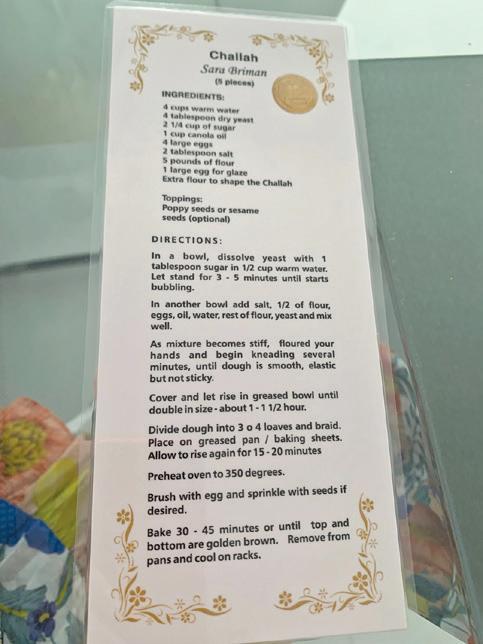
In those days, it took a month for a letter from Mexico to arrive in Poland. As such, Sara’s father waited anxiously for his mother’s arrival. News of the impending war frightened him terribly. And he was nervous that his mother wouldn’t make it to Mexico on time. But to the family’s relief, Sara’s Bubby soon joined them in Mexico. She made it just in time. One month later, the war broke out.
All the while, the family continued searching for Sara’s Zaidy. Soon enough,
they found him in northern Mexico. The family, at long last, was reunited and soon settled down in Mexico City, where Sara and her family still live to this very day.
Sara Briman started out as a culinary student. In the summer, she would attend New York’s Culinary Institute. As she learned the ins and outs of cooking, her dream of becoming a chef was born. Quickly, she became a phenomenal cook—so much so that her friends begged her to teach them how to be as good as her. Soon, the student became the teacher. In her classes, she would teach almost every cuisine—Mexican, Chinese, Indian, Jewish, etc.
Around 1970, Sara took the next leap in her culinary career, jumping into the world of catering. What started as cooking for her friends soon became catering for the government, embassies, and top companies. One Wednesday afternoon in 2013, while rushing to finish a big catering job, Sara got a call from her son, Salvador.
“Mommy, I have a friend. I can really do amazing business with him, and he told me that he loves Jewish food and he would love to taste a delicious challah. I told him that my mother makes a very delicious challah,” he explained. “So, for this coming Friday, can you please make a challah for him?”
“I’m sorry, Salvador. There’s no way I could do that. I have a very important catering job to do by Friday. Tell your friend that maybe Sunday or Monday—any day next week—I’ll bake a challah for him,” she replied.
“But Ma, he’s just coming for two days, and he would really like to taste it,” her son responded. “If you have time, I would really appreciate it, because, believe me, I could really do great business with him.”
“OK, fine,” she sighed. “I’ll make a challah for your friend.”
After finishing her catering job at 9 p.m. Thursday, Sara turned around and spent the entire night baking— not just challahs, but cookies and rugelach, too—for her son’s friend. She finished at seven in the morning, her eyes burning, her body aching. She felt awful—but the challahs were ready. And right at noon, someone knocked on the door.
“I opened the door, and I couldn’t believe it. Suddenly, there were paparazzi taking pictures of me with a professional camera, and seven men walked in. And I said to my son, ‘What’s going on? What is this?’” Sara recalls. “He never speaks English with me, but he says, ‘Mommy, hi, how are you? I want to introduce you to Mr. Jefferson, Mr. Smith, and Joseph Cinque.’ And I said, ‘What’s going on?’”
The men sat down in her living room. Though Sara was confused—her son had only mentioned one friend, yet there were seven people there, cameras flashing—she did what any good hostess would: she offered them the challah she’d spent all night baking.
Then, Mr. Cinque looked up to her and said, “Look, I know that you don’t know who I am, but I just want to let you know that if your challah is worth it, I’m going to
give you an award.”
Sara was lost. What in the world was he talking about—an award? Joseph Cinque took a bite of her challah. He looked back up to Sara, who was still flustered, and he delivered his verdict.
“Sara, I have been traveling all around the world, and I have never tasted a challah like this. This is really delicious. You deserve to have the best award in the world,” Mr. Cinque told her.
Cameras kept flashing at her. It seemed as though her living room was swarming with people.
“Mrs. Briman, I know this is a very special day for you,” a cameraman told her. “Can you talk to the camera about how you’re feeling?”
But she couldn’t talk. She was all choked up and crying—still shocked at what was happening.
Suddenly, the men got up and presented her with three boxes. They opened up the first box. Inside it was a gold medal from the American Academy of Hospitality Sciences that read, “Six Star Diamond Award.” Then they opened up the second box, inside of which was a platinum plate.
“It said ‘The American Academy of Hospitality Sciences has given the Five Star Diamond Award to Sara Briman for her inspiration and dedication to keeping family values and traditions strong.’ And it was signed by the three best chefs of the academy,” Sara recounts.
In the last box were ten books from the best chefs in the world, each signed personally for Sara.
“And then, when Joseph Cinque left my house, he saidto me, ‘In the near future, someone is going to pick

you up, and you’re going to go on a 40-day exclusive cruise to Europe to meet all the best chefs in the world.’ He also invited my husband and my son,” Sara shares. “He left my house an hour before Shabbos at five o’clock. And he’s not a Jewish person. He’s an Italian guy from Europe who started working in Brooklyn with Jewish people. He was talking and talking and talking.”
Joseph Cinque, who gives awards to the world’s greatest chefs, restaurants, and hotels, explained to her that he once enjoyed a delicious challah while working with Jews. And since then, he’s yet to find a challah as tasty. People told him to try challah in Israel. He did just that and wasn’t impressed. Then, he went to England, and then to South Africa, and then to France. But he couldn’t find a challah as delicious as the one he previously had. Ten years went by, and he hadn’t found the world’s best challah—that is, until he tasted Sara Briman’s.
Sara’s daughter, Karen, who sadly passed away at the young age of 30, taught Sara that every ingredient in challah carries a deeply spiritual meaning. Karen also taught her the segulah of the shlissel challah—the custom of baking a key into the challah dough for the Shabbos after Pesach.
“I make my shlissel challah in the regular shape, and I put a key inside—that’s the way Karen taught me. It’s a little key that I bought here in Mexico. I fold it with aluminum foil, and I put it inside and braid it with the challah,” Sara shares. “Karen told me that you have to keep the key with you until the next shlissel challah. And during the year, if you want to show gratitude to Hashem, or you want to ask something of Hashem, you take this key, and you put it next to you, and Shamayim will open for you. And the most important thing that you have to do, first of all, is be very thankful to Hashem for whatever He has done for you. And then, if you want to ask for something, do it. But before that, you have to be thankful. That’s the message I transmit from my daughter.”
Sara has traveled the world, delivering challah presentations in many places, including Mexico, the United States, Canada, South America, China, Japan, and Israel. Currently, she’s writing a book about the secrets of her challah, inspired by the lessons she learned from her daughter Karen, a”h.
The greatest secret behind Sara Briman’s world-famous challahs—the one passed down from Karen and shared with a stunned customer at Starbucks years ago— is still the same today: Sara’s blessings. And her love.

Rabbi & Mrs. Eliezer Epstein on the birth of a daughter
Zevy & Alanna Rubenstein on the birth of a son
Rabbi & Mrs. Sholom Dov Klein on the birth of a daughter

Avramy & Chaya Sara Pollack on the birth of a son
Shmuel & Chemdi Romer on the birth of a son
Dr. & Mrs Yitzy Feldstein on the birth of a daughter
Eli & Elisheva Cohen on the birth of a son
Elchanan & Sarah Palmer on the Birth of a son
Rabbi & Mrs. Uri Garber on the birth of a son
Moshe & Hadar Lavi on the birth of a daughter
My kids are bored. I know this because as I sit here, writing this article, they’re telling me this. They have toys, they have games, they have each other, yet they want me to come up with something to entertain them. And it has to be something more exciting than all the toys and games they have. Why did I get them so many toys and games? Yet they never grow bored of telling me they’re bored. They can do that all day.
So generally, when they tell me they’re bored, I give them a chore. That usually gets them to back down and say, “Never mind,” and find something to do on their own, and then whenever they come near me for the rest of the day, I can hound them about that chore.
But sometimes they’ll actually do that chore and then come back to me, telling me that they’re bored again, which is annoying because that’s entirely not what I wanted. I guess that also means the chore is done, but most of what I ask them to do, I can do myself in less time. Unless it involves bending down.
It’s also not easy to keep constantly coming up with chores for them that I don’t have to supervise or get up afterward to check on. This requires serious thought and creativity, and the whole reason I give them a chore in the first place is that it’s hard to be creative when they’re standing right there telling me that they’re bored.
Usually, I tell them to clean their room. This is a no-brainer. I don’t have to first go upstairs and see if their room
needs to be cleaned; their room always needs to be cleaned. That’s its default state. I have a room that is shared by all my boys, and the floor is covered, wall to wall, by things that belong to nobody. I know this because everyone comes down, one at a time, and tells me that everything that’s theirs is cleaned up. And then I go upstairs and the room is still covered. Are people breaking into the house with their laundry, scattering it on the floors and sneaking out? To what end? So my kids should wash them and scatter them on the floor again? How come they never break in to get the clothes back?
So I send the kids back up, and they stay upstairs and fight about whose stuff is whose. During playtime, they’re always fighting that everything is theirs, but now everything belongs to the other person. This would actually be a great way to break up fights, in general. Whenever your kids are fighting that something belongs to them, just say that whoever’s it is has to clean it up immediately. Suddenly it will be no one’s. It’ll be yours. And you’ll clean it up and put it in the garbage, because you have no use for it, and suddenly it will be everyone’s again.
They even fight over whose dirty laundry is whose. None of them have ever thought about the consequences of insisting that absolutely no clothing is theirs.
You’d think this wouldn’t be possible. Each of my kids has his own laundry basket, because half the difficulty of laundry is sorting three different sizes of the same exact socks that my wife bought so their kids should match each other. And since each child has his own laundry basket, the policy is that when a child’s laundry basket is full, he has to bring it down to be washed. So the kids
By Mordechai Schmutter
try to circumvent this by never putting anything in their baskets.
Ideally, they’re each in charge of bringing their laundry basket down for my wife to wash, and then they bring it up to the living room where my wife helps them fold it, and then she sends them upstairs with it, where they put it in their room without actually entering the room or turning on the lights. I have one kid who keeps stuffing clean laundry behind his bed. I have another kid who can’t do that because he sleeps on the top bunk. So he leaves it in the far corner of his bed, under his blanket.
Then, on Friday (or sooner, if they’re bored) we say, “Clean your room!” and they take all their floor clothing – clean and dirty – put it all in their basket so it’s overflowing, and bring the basket down, because we’re suddenly going to do their laundry late on a Friday afternoon. So it sits in the basement until Sunday, while the kids spend Shabbos throwing their laundry on the floor, because they have no laundry baskets.
I’m not even sure how they live like this. They have dirty clothes on the floor, and they have clean clothes on the floor. How do they tell which is which? And does it matter? If it’s on the floor, it’s not clean. Even if it was. Have you seen the floor? I haven’t. I’m not even sure my kid’s room has a floor. I haven’t seen it in years. I assume it has a floor because it was there when we moved in, and my kids have never picked up anything in their lives.
Mordechai Schmutter is a freelance writer and a humor columnist for Hamodia and other magazines. He has also published eight books and does stand-up comedy. You can contact him at MSchmutter@gmail.com.





THANKS







By Rivka Kramer, PMHNP-BC

By all outward appearances, David had it all. A million-dollar smile, a beautiful family, a waterfront mansion in Miami, and the title of CEO of one of the fastest-growing tech startups in the U.S. His face graced magazine covers. Investors adored him. Employees admired him. But behind the high-rise windows and keynote speeches, David harbored a devastating secret: he was addicted to opioids.
It started innocently after a skiing accident left him with chronic back pain. A prescription for OxyContin turned into a dependency. At first, it worked wonders. But as weeks turned into months, David found he needed more of the drug just to get through the day. When the prescriptions ran out, he turned to colleagues in medicine, then to less reputable sources. Eventually, opioids became part of his daily routine—not for pain relief but for survival. Despite this, he never missed a board meeting. He made quarterly projections, managed multimillion-dollar
deals, and smiled for every camera. But inside, he was unraveling. His marriage strained under the weight of secrecy. His kids noticed he was always either agitated or checked out.
David’s story is not unique. Addiction doesn’t care about status, income, or education. It can affect your brother, your son, your husband, your cousin, your coworker. The people we love and admire can be hiding immense pain behind polished appearances.
While David’s struggle was with opioids, addiction takes many forms. We often associate the word “addiction” with drugs or alcohol, but at its core, addiction is a compulsive, harmful relationship with a substance or behavior that offers short-term relief or pleasure—at the expense of long-term well-being.
Some of the most common non-substance addictions include:
• Alcohol – Legal and socially accepted but just as destructive when abused.
• Gambling – A powerful behavioral addiction that can devastate finances and relationships.
• Food – Emotional eating, binge eating, or compulsive eating can be tied to unresolved trauma or emotional pain.
• Technology and Gaming – Excessive screen time, especially among youth, can become a coping mechanism and lead to physical and psychological consequences.
• Work– Sometimes masked as ambition, overworking can be a way to avoid emotions or feel control.
• Shopping/Spending – The dopamine rush of buying can temporarily soothe anxiety or depression.
In each of these examples, the behavior starts as a means of escape or relief, but over time, it becomes compulsive and damaging. Like drugs, these addictions alter brain chemistry, creating cycles of
dependency, withdrawal, and craving.
Understanding addiction in its many forms helps us broaden our compassion. Someone doesn’t have to hit rock bottom with heroin or meth to need help. They might be drowning in debt from gambling. Or scrolling endlessly on social media to avoid their own mind. Or numbing their pain with food, then wrestling with shame.
The pain is real. The pattern is real. And the need for healing is just as urgent.
Understanding Addiction: More Than a Choice
Addiction is a chronic, relapsing disorder characterized by compulsive drug seeking and use, despite harmful consequences. It is not a moral failure or a lack of willpower – it’s a complex interplay of brain chemistry, environment, genetics, and psychology.
Addiction can stem from trauma, chronic stress, mental illness, or even medical treatments gone awry – as in
David’s case. And while substances vary, the disease mechanism remains frighteningly similar.
When someone uses an addictive substance, the brain’s reward system is flooded with dopamine, creating intense pleasure. Over time, the brain becomes less sensitive to both the substance and natural sources of pleasure. What once brought joy – family, hobbies, even success – no longer feels satisfying. The brain now craves the substance above all else.
For many, the descent into addiction is gradual. It may start with a legitimate prescription for pain relief, stress management, or sleep. But for those vulnerable due to genetics, trauma, or environment, what begins as relief can quickly become dependency – and eventually, a devastating addiction.
Addiction affects millions across the globe and is often paired with mental health challenges like anxiety, depression, or post-traumatic stress disorder (PTSD). These co-occurring disorders make it even more difficult for individuals to break the cycle without comprehensive, integrated care.
David’s story exemplifies this complexity. It wasn’t just about physical pain – it was about emotional pressure, expectations, and the isolation that often accompanies success. Like many high-functioning individuals, he learned to hide his struggles behind a polished exterior.
Many addicts describe this phase as being trapped – knowing the harm they’re causing but unable to stop. This is what makes addiction so devastating and why shaming someone into quitting almost never works.
Factors that contribute to addiction include:
• Genetics – Up to 50% of addiction risk is inherited.
• Mental health – People with anxiety, depression, PTSD, or ADHD are more vulnerable.
• Trauma – Childhood abuse, neglect, or unstable environments are strong predictors.
• Social environment – Peer pressure, accessibility of drugs, and societal norms all play a role.
In David’s case, the root wasn’t just physical pain – it was also the immense pressure of maintaining an image of perfection.
Treatment: There Is Hope Recovery is possible – and it begins with recognizing addiction as a treatable
disease, not a personal defect. Effective treatment is holistic, combining medical, psychological, and social approaches.
1. Detoxification
This is the initial phase of treatment where the body clears the drug. Medical supervision is crucial, especially for substances like opioids or alcohol, where withdrawal can be dangerous.
2. Medication-Assisted Treatment (MAT)
Medications such as buprenorphine, methadone, and naltrexone help manage cravings and prevent relapse. MAT is evidence-based and has saved countless lives.
3. Therapy and Counseling
Therapy is essential for uncovering the root causes of addiction. Cognitive Behavioral Therapy (CBT) helps people recognize and reframe the thoughts and beliefs that drive their compulsions. Dialectical Behavior Therapy (DBT) builds emotional regulation and distress tolerance skills.
For behavioral addictions, therapy focuses on breaking the reward cycle, improving impulse control, and developing healthier ways to meet emotional needs.
4. Support Networks
Twelve-step programs like Narcotics Anonymous, and non-12-step alternatives like SMART Recovery, offer com munity and accountability.
5. Long-Term Support
Recovery doesn’t end at rehab. On going therapy, lifestyle changes, sober living environments, and relapse pre vention strategies are vital for long-term success.
David’s recovery involved all of the above. He stepped down from his com pany, spent six months in a residential treatment facility, and now speaks pub licly about his journey – turning his darkest moment into a message of hope.
A Community Responsibility: How We Can Help
Addiction doesn’t only affect indi viduals – it affects families, workplaces, neighborhoods, and entire communities. Healing, therefore, must also be a col lective effort. When we recognize our shared humanity and reject stigma, we create a culture of support rather than shame.
1. Change the Narrative Words matter. When we refer to peo ple as “addicts,” “drunks,” or “junkies,” we reinforce harmful stereotypes. In stead, we can use people-first language: “a person with a substance use disorder.” It’s a small change with big impact.
Stigma keeps people from seeking help. Compassion opens doors.
2. Encourage Connection
Isolation is both a cause and consequence of addiction. A simple conversation, a check-in, or an invitation to connect can make a world of difference. Ask how someone is really doing – and be willing to listen.
If someone opens up about their struggles, respond with empathy, not advice. Say, “Thank you for sharing that with me. I’m here for you.”
3. Support Family Members
Addiction can tear families apart. Loved ones often feel helpless, frustrated, or ashamed. But they, too, need support. Resources like Al-Anon, Nar-Anon, or therapy for family members can offer guidance, boundaries, and healing.
When we support families, we also support recovery.
4. Promote Access to Treatment
Advocating for better access to mental health services, affordable rehab, harm reduction tools (like naloxone and clean syringe programs), and recovery housing makes a direct impact. Policies that treat addiction as a health issue –not a criminal one – save lives. Workplaces can also play a key role by
offering Employee Assistance Programs (EAPs), mental health days, and reentry opportunities for employees in recovery. Employers who treat recovery with dignity contribute to a healthier, more productive culture.
The Face of Addiction is All Around Us
It’s easy to miss. A manager quietly struggling in his office. A mother relying on wine to get through the day. A cousin who’s been “not quite right” since that car accident. Addiction wears many faces – and none of them look like what we imagine.
But recovery wears a face, too. It’s in the father who shows up to every soccer game now. The sister who just hit her one-year sober mark. The coworker who opens up about therapy. Recovery is real. And it’s possible.
Rivka Kramer is a Board Certified Psychiatric Nurse Practitioner. She has a psychiatric private practice based in Cedarhurst, NY. She serves as a member of the board of JANPPA, the Jewish American Nurse Practitioner Psychiatric Association. She can be reached at 516-945-9443.





By Rabbi Azriel Hauptman



our friends in adulthood. Why does our circle of friends in adulthood rarely resemble our friends from childhood? In this article, we will attempt to shed some light on this common phenomenon.
Before we do that, we must define the term “friend”. That is not as easy as you might think, as none other than the Rambam in his commentary on Avos (1:6) cites Aristotle as saying that there are three basic categories of a “Chaver”. For our purposes, we will loosely define a friendship as containing three essential components. Two people who enjoy spending time with each other, the relationship is positive, and they can rely on each other for support.
Certainly, proximity is usually the background upon which friendships evolve, but proximity and shared experiences by themselves are not enough to create a friendship. This is why you can be a co-worker with someone for many years and have shared many life experiences together, but as soon as you change jobs your friendship with that person may peter out. Similarly, you may have a nextdoor neighbor for decades, then you move a few miles away, and you lose touch.
This leads to the question, why do some of our childhood friendships last the test of time and some of them fizzle out in adulthood? This is a very complicated question and has many parts, but we will focus on one of them, and that is the role of our core identity.

When we are young, our core identity has not yet been formed and we can bond with our playmates over superficial shared elements of our lives. If we both like playing the same games, we can become good friends and bond over our shared interests. What are your deepest

goals, interests, and aspirations at that age? Usually, very little, if any.
As we start to get older, we start to develop a core identity. We start developing specific goals for our lives that were non-existent a few years earlier. We also start to discover mature interests that are immeasurably deeper than those that occupied our minds in childhood.
As a result, when you emerge into adulthood, you might find that someone who was our closest friend a couple of years ago now feels much more distant. You used to bond with your friends by schmoozing about the latest hock, but that no longer interests you and that cannot possibly form the basis of a deep and meaningful relationship. As your personality becomes deeper and searches for more meaning, similarly your desire for friends is for friends who can connect with your innermost feelings.
This does not mean that your childhood friendships are necessarily over or that you should not put effort into maintaining them. It merely means that you might not be able to feel as close to your old friends as you once used to.
There is a famous saying, “Tell me who your friends are, and I will tell you who you are.” Your true friends are not simply people who you hang out with, but they are a reflection of you. As you change, so does your reflection.
This is a service of Relief Resources. Relief is an organization that provides mental health referrals, education, and support to the frum community. Rabbi Yisrael Slansky is director of the Baltimore branch of Relief. He can be contacted at 410-448-8356 or at yslansky@ reliefhelp.org
By Etti Siegel


Q:Dear Etti, It is that time of year again. My kids just don’t want to go to school. I think it is “Spring Fever” – they just want to play outside. Getting them out the door in the mornings is a struggle.
Help!
- Harried (and Needs to Hurry in the Mornings)
A:Dear Harried, Thank you for reaching out. This is a very timely concern! As we head into the final stretch of the school year, many kids, both younger and older, start to lose motivation. The weather’s warmer, the days are longer, and summer is just around the corner. For younger kids, it’s often a case of classic “Spring Fever.” For older students, it’s more likely burnout after ten months of classes, projects, and tests. Either way, it’s normal for motivation to dip this time of year – and there are ways we can help.
For younger kids, embrace the wiggles! Instead of fighting their urge to move, try working with it. Just 20 minutes of aerobic activity before homework, like biking, jumping on a trampoline, or dancing with DJ Raphie or Danny Go! can really boost focus and make study time more productive.
Bringing back a bit of structure can also help. If routines have loosened up, reintroduce small ones – like a regular homework slot or a visual checklist for school supplies. Taking 10 minutes each Sunday to look at the week ahead can reduce last-minute stress and give your child a sense of control.
Motivation at this age often works best with immediate, small rewards. Think: an extra bedtime story, a favorite snack, or bonus playtime after homework. These short-term incentives keep kids engaged without making them wait until summer for a payoff.
For older students, think tired, not lazy. By now, many teens are simply worn out. Final exams, big projects, and extracurriculars can pile on the pressure. Start by validating their feelings, “I get it;this time of year is tough,” so they feel heard and supported.
These short-term incentives keep kids engaged without making them wait until summer for a payoff.
Help them break big assignments into manageable steps, like tackling a paper one stage at a time: research, outline, write, and revise. A small, day-by-day plan is much less overwhelming than a looming deadline.
Shaking up their routine can help, too. A change of scenery, like studying outside or in a different room, or switching up study methods can make things feel fresh. And like with younger kids, short-term rewards tied to effort (“study for 30 minutes, then take a break”) are more effective than distant promises tied to grades.
And don’t forget; physical movement helps older students, too. Even a short walk or a few stretches can help them recharge and refocus.
In some cases, a student’s reluctance to engage in schoolwork goes beyond the usual Spring Fever or burnout. School refusal, as described by psychologist Rachel Busman, PsyD, ABPP, is not the same as truancy; it’s not about skipping school for fun but rather a deeper struggle with anxiety, stress, or negative associations with the school environment. Signs of school refusal may include frequent complaints of physical symptoms like headaches or stomachaches that tend to disappear on weekends or holidays, extreme distress when it’s time to go to school, persistent tardiness, or frequent visits to the school nurse. If your child often asks to text or call home during the school day, this could also be a sign.
My friend had a daughter in junior high school who began crying every Sunday night at 7:00 PM – every single Sunday night, without fail, like clockwork.
Addressing school refusal early is crucial, as the longer a child avoids school, the harder it becomes to reintegrate. Start by having an open and honest conversation with your child to understand what’s driving their reluctance – it could be bullying, academic struggles, or social anxiety. Collaborating with their teacher, school counselor, or even a therapist can help uncover the root cause and develop strategies to address it. In more serious cases, connecting a child with a competent therapist can be a valuable resource (especially when paired with parental support), offering them a safe space to open up, express their emotions, and work through anxiety or difficult situations.
For my friend’s daughter, validating, giving the situation space, and letting her come up with ways to lessen her anxiety seemed to help, and over time, it went away. Whether your child is dealing with Spring Fever, burnout, or deeper school-related anxiety, the key is to support them while holding them accountable. Maintaining structure, offering short-term incentives, breaking tasks into manageable pieces, and incorporating physical activity into their routine can make a big difference. And remember, open communication is vital. Listening to your child’s concerns and validating their feelings can help build trust and open the door to finding solutions together.
The end of the school year can feel like a marathon for both students and parents, but with a little encouragement and some strategic adjustments, it’s possible to help kids finish strong.
Summer is just around the corner, so hang in there; you (and your children) are almost at the finish line!
Hatzlacha, -Etti
Mrs. Etti Siegel holds an MS in Teaching and Learning/Educational Leadership and brings sound teaching advice to her audiences culled from her over 35 years of teaching and administrative experience. She is an Adjunct at the College of Mount Saint Vincent/Sara Shenirer. She is a coach and educational consultant for Catapult Learning, is a sought-after mentor and workshop presenter around the country, and a popular presenter for Sayan (a teacher-mentoring program), Hidden Sparks, and the Consortium of Jewish Day Schools. She is a frequent contributor to Hamechanech Magazine and The Journal for Jewish Day School leaders. She will be answering your education-based questions and writing articles weekly for The Jewish Home. Mrs. Siegel can be reached at ettisiegel@gmail.com.

TBy Eliezer Kreiser
he Akeidah compares the Jewish Nation to G-d’s creation of the world and all that is in it. Just as G-d created the world and provided every facet of creation - from the microscopic to the gargantuan - with the wherewithal to provide for and sustain themselves, so too the Jewish Nation. Chosen to be G-d’s treasured nation, the People were told at Mount Sinai (Shemos 19:5,6)
- You shall be My most treasured nation… a nation of Kohanim and a



holy nation. Tasked with becoming a majestic and holy nation, the Jewish People were endowed by the Almighty with the necessary resources and abilities to rise to that lofty status and indeed reach it.
Similarly, the blessings of the Land of Israel are described by the Torah in multiple ways. Among them is (Devarim 8:9)
A Land from which you will not







Yitzchok Fine & Chani Feldman
Yonasan Klatzkow (GW) & Russy Hirsch (Passaic)
eat bread out of poverty, there you will lack for nothing. The Land, too, was endowed with the blessings and resources necessary through which we can fulfill the mitzvosand further sustain the holiness of the Land as well as sanctify ourselves.
To prevent spiritual harm, the Torah cautions us regarding negative actions and behaviors that would impede the exalted levels we yearn for and prevent us from maintaining our exclusive role as a Nation of Kohanim and a Holy Nation. The mitzvos we are commanded to observe and fulfill serve as purifiers, refining and perfecting, enabling us to live sanctified lives in this world and in the World to Come.
In this week’s Parshah, Parshas Shemini, the Torah catalogues the permissible and prohibited animals, fowl, and fish. These forbidden foods are damaging to our spiritual rather than physical health. Ingesting these foods encases our hearts with an obstructing film that precludes holiness from penetrating. The exclusivity of our Nation’s status is thus at risk of being negated.
At the end of the parshah (Vayikra 11:43) the Torah reiterates in strong terms the pernicious effect of non-kosher foods,
Do not make yourselves abominable by means of teeming things lest you become contaminated through them The Gemara(Yoma 39a) expounds on this verse, teaching us that if a person contaminates himself a bit, he will be contaminated a great deal. Rashi explains that if you
allow yourself be contaminated even slightly, it will lead you to becoming contaminated greatly. The Torah warns us that a scintilla of contamination will surely be followed by a profusion. The concept of a tad of contamination does not exist.
The Gemara continues and quotes the following verse (Vayikra 11:44),
You shall sanctify yourselves and you shall be holy, which teaches us the converse of the above; if a person sanctifies himself even a bit, he becomes sanctified a great deal. Every mitzvah that a person fulfills, every negative temptation a person withstands, leads to increased sanctity.
However, our natural inclinations are predisposed towards the physical. Rabbeinu Bachya explains the words You shall sanctify yourselves and you shall be holy as the Torah's prescription for fortifying oneself to withstand the physical temptations of this world. With every mitzvah we observe we “fill the prescription”, acquiring Kedushah – sanctity - which enables us to rise above and withstand sinful and destructive enticements.
םכשדקתהו - sanctify yourselves with mitzvos. And subsequently, םישדק םתייהו- through them you will be sanctified.
Rabbi Eliezer Kreiser is the Rav of Ezras Israel of Rockville and is the Mashgiach of the Yeshiva of Greater Washington.








































































Understanding “Tax-Free” Assets and When They Make Sense for You
If you’ve been hanging around the world of personal finance for a while, you’ve probably heard financial planners, bloggers, and even your savvy cousin rave about the Roth IRA. But what makes a Roth IRA so special? In one word: tax-free
Let’s dive into what a Roth IRA is, why it’s so great, and when it’s the right choice for you.
What Is a Roth IRA?
A Roth IRA is an individual retirement account that allows you to contribute after-tax dollars today and enjoy tax-free growth and withdrawals later.
Here’s how it works:
1. You Pay Taxes Now: Contributions to a Roth IRA are made with money that’s already been taxed (unlike traditional IRAs or 401(k)s).
2. Tax-Free Growth: The investments in your Roth IRA grow without Uncle Sam taking a cut.
3. Tax-Free Withdrawals: When you withdraw funds in retirement (as long as you meet certain conditions), you won’t pay a penny in taxes.
Why a Roth IRA Is So Great
1. Tax-Free Retirement Income
Imagine reaching retirement and not worrying about taxes eating into your nest egg. With a Roth IRA, every dollar you withdraw (after age 59½ and meeting the five-year rule) is yours to keep. No guessing what future tax rates will look like—it’s tax-free, period.
2. Flexibility in Retirement
Unlike traditional IRAs, Roth IRAs don’t require required minimum distributions (RMDs) when you get older. This gives you greater control over your retirement income, allowing your investments to grow tax-free for as long as you like.
3. Tax Diversification
Having a mix of taxable, tax-deferred, and tax-free accounts in retirement is like having financial armor. A Roth IRA provides a taxfree bucket you can tap into during high-tax years, giving you more options and flexibility.
4. Great for Younger Investors
The earlier you start, the more time your money has to grow tax-free. A 25-year-old contributing $7,000 per year to a Roth IRA could amass hundreds of thousands of dollars in tax-free wealth by retirement.
5. No Taxes on Your Heirs
Roth IRAs can be a great estate planning tool. Your beneficiaries can inherit your Roth IRA and enjoy tax-free withdrawals, subject to certain rules.
When Does a Roth IRA Make Sense?
1. You Expect to Be in a Higher Tax Bracket Later
If you’re early in your career or earning less now, it’s a great time to lock in today’s lower tax rates by contributing to a Roth IRA.
2. You Want to Maximize Tax-Free Growth
If you have decades ahead of you before retirement, a Roth IRA can take advantage of the compounding magic of tax-free growth.
3. You Don’t Need the Money Right Away in Retirement
If you’re looking to minimize taxable income in retirement and don’t need RMDs, a Roth IRA is a great choice.
4. You Want a Hedge Against Future Tax Increases
If you’re concerned that tax rates will rise in the future (and let’s face it, they probably will), a Roth IRA offers protection by locking in taxfree withdrawals.
2025 Contribution Limits and Income Phase-Out Ranges
For 2025, the IRS has set the following limits:
• Contribution Limit: You can contribute up to $7,000 per year. If you’re 50 or older, you can contribute an additional $1,000 as a catch-up, for a total of $8,000
• Income Phase-Out Ranges:
o Single Filers:
o Full contribution: MAGI below $150,000
o Partial contribution: MAGI between $150,000
By Elliot Pepper, CPA, CFP®, MST

and $165,000
o No contribution: MAGI above $165,000
o Married Filing Jointly:
o Full contribution: MAGI below $236,000
o Partial contribution: MAGI between $236,000 and $246,000
o No contribution: MAGI above $246,000
o Married Filing Separately:
o Partial contribution: MAGI between $0 and $10,000
1. Check Your Eligibility
Determine your MAGI and ensure it falls within the contribution limits for your filing status.
2. Open an Account
Choose a trusted brokerage like Vanguard, Fidelity, or Charles Schwab to open your Roth IRA.
3. Choose Your Investments
Select a mix of stocks, bonds, ETFs, or mutual funds to align with your financial goals and risk tolerance.
4. Consider a Roth Conversion
If your income exceeds the eligibility threshold, explore options like a backdoor Roth IRA or converting traditional IRA funds into a Roth IRA.
The Bottom Line
A Roth IRA is one of the most powerful tools in your financial toolbox. Its tax-free growth, flexibility, and estate planning benefits make it a standout choice for many savers. However, it’s important to evaluate your unique situation, including your current income, tax bracket, and retirement goals, to determine if a Roth IRA is the right fit for you.
At Northbrook Financial, we’re here to help you navigate these decisions and create a financial plan that works for you. Contact us today to discuss how a Roth IRA can fit into your overall strategy.
Subscribe to Common Cents digitally on LinkedIn @CommonCents613
The decision to start saving and investing is yours, but the “how” can be hard. Email commoncents@northbrookfinancial.com to schedule a financial planning consultation with our team.
Elliot Pepper, CPA, CFP®, MST is Co-Founder of Northbrook Financial, a Financial Planning, Tax, and Investment Management Firm. He has developed and continues to teach a popular Financial Literacy course for high school students.



















1. That you can learn to do heart surgery, build a nuclear reactor, and train a falcon—all before breakfast.

2. That watching one guitar tutorial automatically makes you think you’re ready to headline Coachella.

3. That the best way to find a two-second answer is by watching a 10-minute video with a 30-second unskippable ad and a guy who says “Uhhh” 83 times.

4. That people will film themselves opening a cardboard box and somehow earn more than a surgeon.

5. That “DIY” means “Destroy It Yourself” for 90% of us.

6. That every travel vlogger is legally required to say the word “authentic” at least six times per video.

7. That you could accidentally become an expert in Mongolian throat singing, vintage pencil sharpeners, or 18th-century bread recipes—just because the algorithm had a weird day.

8. That every appliance can be fixed with a screwdriver, duct tape, and a 9-minute video made in someone’s garage—with royalty-free background music that’s somehow louder than the guy explaining it.


your kitchen looking like it hosted a toddler food fight.

10. That there are exactly 14 ways to pronounce “tutorial.” None of them sound right.

11. That people will watch others clean their house instead of cleaning their own.

12. That “don’t forget to like and subscribe” is the new “have a nice day.”

13. That every single subject in human existence has at least one guy with glasses and a podcast mic saying, “Actually…”

14. That if someone says, “This is NOT clickbait,” it definitely is.

15. That no matter how niche your interest is, someone else not only shares it, they’ve reviewed the top 10 products for it, they’ve interviewed the experts, and they’ve monetized it.

9. That a one-minute recipe video will always take 23 minutes to replicate, involve six bowls, and leave

16. That you don’t necessarily need to go to the Ohel to watch videos of the Rebbe.

17. That there’s a rabbit hole for everything.

18. And that Baby Shark can really get stuck in your head for hours on end. “Baby shark do doo dododoto…baby shark do do dododoto…” You are welcome!
1. What was the first video (a total of 18 seconds) ever uploaded to YouTube?
a. Charlie Bit My Finger (showing a dog biting its owner’s finger)
b. Me at the Zoo (showing a young man talking about elephants)
c. The Cat Fall (showing a cat fall off a counter)
d. David After Dentist (showing a little boy talking about his pulled tooth)
2. Who bought YouTube in 2006 for $1.65 billion?
a. Apple
b. Microsoft
c. Google
d. Facebook
3. How many hours of video are uploaded to YouTube every minute?
a. 30
b. 100
c. 500
d. 6,000
4. According to financial analysis,

if YouTube was a stand-alone company, how much would it be worth today?
a. $1.7 to $2.4 billion
b. $9.5 to $17 billion
c. $82.5 to $112 billion
d. $475 to $550 billion
5. Which YouTube video held the record for most views for over 5 years?
a. Baby Shark
b. Gangnam Style
c. One Bite Everyone Knows the Rules
d. Hide Your Kids, Hide Your Family
6. Which YouTube channel has the most subscribers, totaling 386 million?
a. MrBeast
b. PewDiePie
c. Kosher Money
d. Cocomelon
7. What is the most viewed YouTube video of all time, with 14 billion views (that’s 1.5 views for every person on Earth)?
a. Trump assassination attempt
I told my friend I was thinking of starting a YouTube channel.
He said, “What’s your niche?”

b. Kennedy assassination
c. Moon landing
d. Baby Shark
8. How many hours of YouTube are watched every day?
a. 4 million
b. 17.6 million
c. 42 million
d. 1 billion
Answers:

Wisdom Key:
6-8 correct: You are a great YouTuber! Just push the “Like” button, and we will be all set!
3-5 correct: You got stuck on the Shorts. Bro, they are a loop!
0-2 correct: You played Baby Shark one too many times and fried your brain cells.
I said, “Existential dread, awkward pauses, and snacks I eat too loudly.”
He nodded and said, “Ah, so you are starting a podcast!”
“Say

Hashem is the most important party in the coalition.
- Prime Minister Netanyahu during a shiva phone call with Minister of Labor Yoav Ben Tzur

I’m almost at a loss for words for how outrageous it is. Here’s an individual—the man who has been deported to his home country of El Salvador—who has been repeatedly documented by multiple federal and state authorities to be a member of MS-13… An individual who has been involved in human smuggling and human trafficking. An individual who is a documented woman beater— somebody who has viciously attacked a woman in ways that shock the human conscience. That is who the Democrat Party is going to provide aid, solace, and comfort to?
- White House Deputy Chief of Staff Stephen Miller commenting on Maryland Democrat Senator Chris Van Hollen’s trip to El Salvador to meet with deported illegal alien and MS-13 gang member Kilmar Abrego Garcia
Van Hollen has not contacted our family and has not provided support in the wake of my daughter’s murder by an illegal immigrant from the same country as Abrego Garcia. Yet the Maryland Democratic senator is willing to spend American taxpayer money to travel to El Salvador and put the interests of a known illegal immigrant before that of his constituents in Maryland.
- Maryland resident Patty Morin whose daughter was murdered in 2023 by an illegal alien from El Salvador
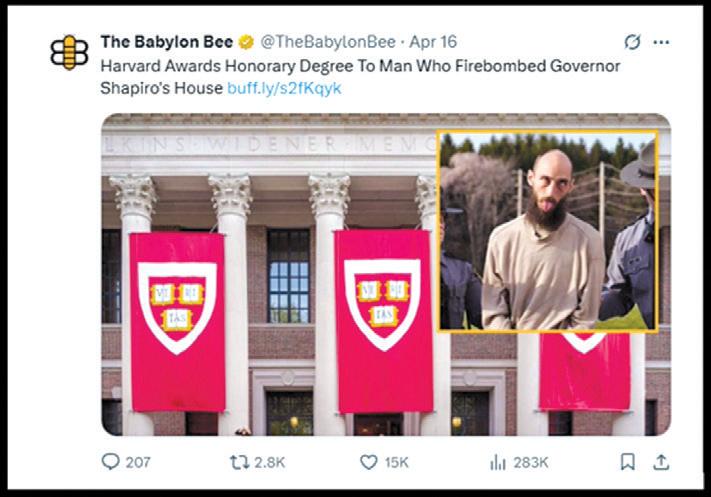
Mahmoud Khalil — the Palestinian activist and legal United States resident whom President Donald Trump’s administration is attempting to expel — can be deported… It’s of particular resonance that this decision came down on the eve of Passover. When we sit down to read the Haggadah during the first Seder on Saturday night, we will be discussing the story of Jews’ refusal to be used in a tyrant’s narrative. The story of Passover is the story of our community’s rejection of the role assigned to it by an authoritarian and of their courage to imagine something different and better. I will read that story, and think about how my government is trying to deport Khalil for his beliefs in the name of the Jews.
- Emily Tamkin writing in The Forward (allegedly a Jewish publication) that Jews should stand with Mahmoud Khalil, a vile Jew hater who came to the U.S. to spark antisemitic protests at Columbia, proving once again that TDS is a very serious mental health disease that warps the mind and destroys the soul
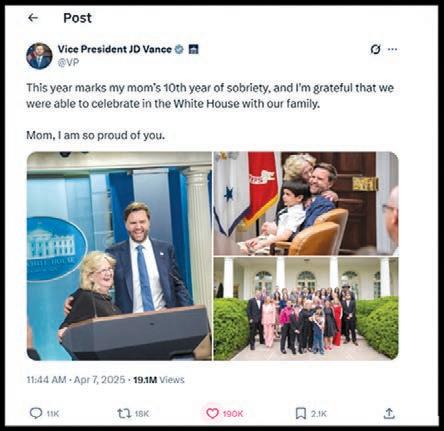


First and foremost, we did not launch an attack to start the war. It seems to me that the vice president is somehow justifying Putin’s actions. I tried to explain, you can’t look for something in the middle. There is an aggressor, and there is a victim. The Russians are the aggressor, and we are the victim.
- Ukrainian President Volodymyr Zelenskyy on “60 Minutes” last week
I think it’s sort of absurd for Zelenskyy to tell the [American] government, which is currently keeping his entire government and war effort together, that we are somehow on the side of the Russians.
- Vice President JD Vance in response

So I had to go around the country and educate people about what immigrants do for this country… The fact is ain’t none of y’all trying to go and farm right now…We done picking cotton!
– Squad member Rep. Jamine Crockett (D-TX) speaking at a historically Black church
I consider AOC to be the leader of the Democratic Party. And, I think that she’s the reason that there’s directions on a shampoo bottle.
– Sen. John Kennedy (R-LA) on Fox News
Our plan for dealing with her is “Operation Let Her Speak.”
- ibid.
Two weeks ago, Democrats were arguing that Trump was only interested in helping his billionaire buddies. Now, they’ve lost millions and are begging Trump to change course. How do we square that circle?
- Tweet by David Marcus

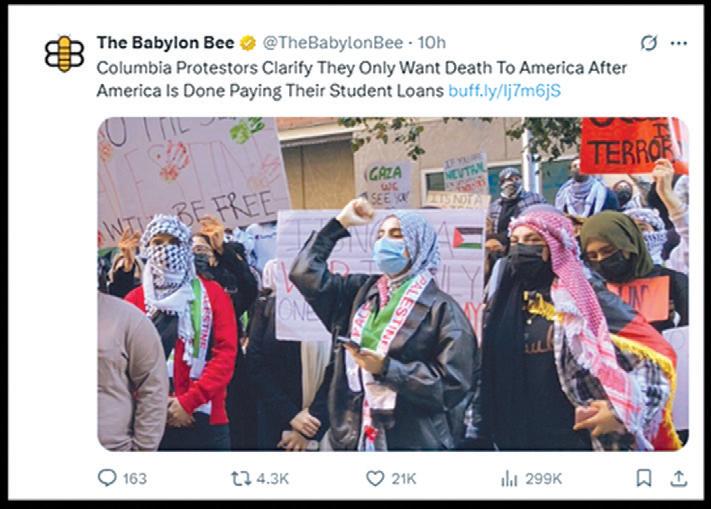

I’m sure you wouldn’t like to be compared to a Trump supporter, but how people cannot understand why people have sympathies for Mangione strikes me as the same as a lot of media not understanding why people support Trump.
- CNN senior correspondent Donie O’Sullivan talking to Taylor Lorenz (former Washington Post and New York Times reporter) about Luigi Mangione who killed an innocent man—who was a father and a husband—in cold blood because he disagreed with how his insurance company conducted business
You’re going to see women, especially, that feel like, oh my G-d, here’s this man who’s a revolutionary, who’s famous, who’s handsome, who’s young, who’s smart. He’s a person who seems like a morally good man, which is hard to find.
- Lorenz, in response, talking about the vile murderer


















Moderated by Jennifer Mann, LCSW of The Navidaters

Dear Navidaters
I never imagined I’d be writing one of these letters — I always thought things would just “work out” like they did for my older kids. But here I am, lying awake at night, wondering what more I can do for my daughter, Chani*.
She’s 24, warm, thoughtful, with a real sense of achrayus for others. She volunteers weekly with kids who have special needs, she bakes challah for neighbors without being asked — and she never complains, even though I can see how much the shidduch parsha is wearing on her. She’s been dating seriously for almost four years. We’ve had some good prospects — boys who seemed like strong fits on paper — but for one reason or another, things keep falling through after just a few dates.
What hurts most is that lately, she’s been getting less and less attention from shadchanim. Some won’t even return our calls unless we “follow up” several times. And when I do hear back, it’s the same vague, noncommittal language: “She’s lovely…but just not what he’s looking for.” I’m starting to feel like we’re caught in a system that doesn’t have room for nuance, or for a girl like Chani — someone who’s not flashy, not from “the right family,” but full of real substance.
How do I help my daughter stay hopeful without feeding into a system that feels increasingly superficial? Is there something broken here, or is this just how it is?
Sincerely,
A Disappointed Mother
Disclaimer: This column is not intended to diagnose or otherwise conclude resolutions to any questions. Our intention is not to offer any definitive conclusions to any particular question, rather offer areas of exploration for the author and reader. Due to the nature of the column receiving only a short snapshot of an issue, without the benefit of an actual discussion, the panel’s role is to offer a range of possibilities. We hope to open up meaningful dialogue and individual exploration.

Dear Readers,
We want to offer YOU an opportunity to be part of the discussion! Please email us at MichelleMondShadchan@gmail.com, subject line “reader’s response,” if you would like to participate in the new “A Reader’s Response” columnist spot. We will send you a question and publish your answer in an upcoming Navidaters edition.
If you have a question you would like the Navidaters to answer, please reach out to this email as well.
Looking forward!
Michelle, the “Shadchan”
Rebbetzin Faigie Horowitz, M.S.
It is smart to focus on helping and supporting your daughter, not on anger at
the system. Hashem has a plan for each of us and the search for her partner in life is part of it. Do your hishtadlus with tefillah, positive support, and networking actively with people you know and who know her in broadening circles both in town and out of town if she is OK with that. Sensitively encourage her to go a lit-
tle beyond her comfort zone in terms of communities and seek support if she feels she needs it. Do encourage understanding that she is a wholesome, capable, kind person with a lot to offer.
For yourself, perhaps reach out to a therapist and/or a support group of mothers with children in shidduchim. Remember that your daughter is an adult, and so are you.
Michelle Mond
I’m so sorry for what you’re going through. It’s clear you’re an incredible mother, and the way you’re supporting your daughter is inspiring.
Even in the quiet moments when nothing seems to be happening, that doesn’t mean the right one isn’t on his way.
You mentioned worrying that there’s no place for a girl like Chani – modest, sincere, not flashy – but I beg to differ. It sounds like she has gotten a decent number of dates in the past, which says a lot. There are definitely families out there who are looking for a girl exactly like her. Let that be a sign that her qualities are being noticed, even if the right one hasn’t come along yet. It’s not a reflection of her





worth — just timing.
As for the shadchanim, you’re definitely not the first (or the hundredth) to express frustration with the system. The world of shidduchim is built around well-meaning, hardworking volunteers. They aren’t being neglectful on purpose; they’re overwhelmed, unpaid, and simply stretched way too thin. It’s one of the only major communal needs that’s still run almost entirely by volunteers, with no formal infrastructure. Unless you’re working with someone privately on a paid, one-on-one basis, there’s unfortunately no way to guarantee a consistent follow-up.
But that doesn’t mean you’re powerless. Hashem is the ultimate Shadchan, and He’s got Chani’s back 24/7. As long as she’s doing her proper hishtadlus, and it sounds like she absolutely is, then the right person will come. It’s just a matter of when.
In the meantime, here are a few things you can do to keep Chani on people’s radar.
Show appreciation: Reach out to shadchanim who have been helpful in the past
with her updated resume, and thank them – even a simple message goes a long way.
Small gestures: Sending a thoughtful erev Shabbos gift or flowers as a token of thanks can help keep her top of mind.
Expand her network: Have Chani visit friends in other communities and meet new shadchanim there or attend events geared toward singles in those areas.
Most importantly, for your sake and Chani’s, try to retain a positive attitude. Keep davening. Your daughter is doing all the right things, and you’re supporting her in the best possible way. That counts for so much and the right one will come iy”H.
Dr. Jeffrey Galler
It’s heartbreaking to witness so many of our wonderful young women, with so much to offer, struggling within a contemporary system that is outdated, dis-
The Navidaters
Dating and Relationship Coaches and Therapists
Reading your letter, I could feel how much you love your daughter –how proud you are of who she is and how deeply you want to see her loved, chosen, and seen for the incredible person she is. Chani sounds like a gem. The kind of girl people don’t always notice at first because she’s not loud or flashy, but once you know her, you realize she’s the real thing. It’s so painful to watch someone you
love strug- gle in a process that feels so uncertain and often so unfair. And when it’s our own children, we feel their pain just like, if not more, than our own, especially when you know, truly know, what she has to offer. And when you’ve seen it go more smoothly for your other children, it’s only natural to wonder why this feels so differ-
tressing, and ill-suited to the realities of the 21st century.
Yes, I know, readers are tired of hearing how “in the good old days” young people met and socialized naturally in places like school, shul, and community events. But it’s still worth reflecting on the contrast with our current, deeply flawed system.
At first, I was going to suggest that you get clearer answers from shadchanim about why boys whom your daughter had liked didn’t reciprocate; encourage her to broaden her “checklist” for dating; and, perhaps, become more involved in community volunteer work to raise her visibility.
But then, I reached out to a good friend who is a highly successful shadchan at YUConnects. This is what she advised:
This is a very familiar story. I get calls like this from heartbroken mothers at least once a week.
#1 – Stop blaming shadchanim. They are trying their best. Most are volunteers, and they didn’t create this “broken” system; they’re just trying to help. People get so stuck blaming and building anger toward the very people who are actually trying to help. Instead, try appreciating their effort and remembering that they’re not the only
ent and so much harder.
You asked if something is broken, and the truth is maybe yes. Not your daughter, not you, but the system. It often misses the quiet depth and kindness that makes someone a truly exceptional partner. It favors neat boxes and categories, resumes and first impressions, and it can be brutal on the heart. But even in all of that, even in the quiet moments when nothing seems to be happening, that doesn’t mean the right one isn’t on his way.
You don’t have to promise her it will all work out soon. None of us can know
Her worth isn’t defined by how quickly she gets married.
#2 – Encourage other avenues for growth. Start looking for other opportunities that let your daughter shine. Encourage her to pursue things that bring her joy and growth — whether that’s career, friendships, chessed, or learning. Confidence and happiness are magnetic, and the more she thrives, the more others will notice.
#3 -Reassure her (and yourself). Remind her that she’s not “behind” and that everyone has their own timeline. Her worth isn’t defined by how quickly she gets married. Keep davening, stay hopeful, and trust that the right person will value her for exactly who she is.
We pray that all of our singles find their lifelong partners easily and painlessly, and enjoy long, healthy, happy lives together.
that. But you can remind her that her story isn’t late, and she’s not behind. The right person just hasn’t walked in yet. And in the meantime, she’s already living a meaningful life, one filled with kindness, generosity, and integrity. That matters. That counts.
Sometimes, the greatest gift a mother can give is to sit beside her daughter in the not knowing and keep reminding her, gently and consistently, that she is not alone and she is not doing anything wrong. You’re already doing that.
Sincerely,
Jennifer
Jennifer Mann, LCSW is a licensed psychotherapist and certified trauma healing life coach, as well as a dating and relationship coach working with individuals, couples, and families in private practice at 123 Maple Avenue in Cedarhurst, NY. To set up a consultation or to ask questions, please call 718-908-0512. Visit www.thenavidaters.com for more information. If you would like to submit a dating or relationship question to the panel anonymously, please email JenniferMannLCSW@gmail.com. You can follow The Navidaters on FB and Instagram for dating and relationship advice.

By Rabbi Shraga Freedman
Recently I received the following email:
We had a not-yet-frum friend over for a visit who used to live in Baltimore but now lives in a different city. She went for a walk around the block and came back glowing.
She couldn’t get over how many people wished her “Good Shabbos” or “Shabbat Shalom”—even little children. She said what she misses most about Baltimore is the
“Did I know him?” the woman repeated emotionally. “I certainly did! When your father was alive, he would come into this building every morning in a hurry and rush to push the button for the elevator; it was clear that he was very busy. But while he was waiting for the elevator, he would come back to my desk and wish me a good morning with a huge smile. And I could tell that he meant it!”
occupied by an overwhelming majority of irreligious families; only one of his neighbors was religious. Yet that religious neighbor was always particular to greet the man warmly every time he encountered him in the stairwell. Eventually, the man realized that if his religious neighbor could constantly radiate such joy, it must mean that his life was filled with meaning and fulfillment. He resolved to explore that life for himself, and that is how he became a
inable area of the Torah. Furthermore, he was a leader of Klal Yisrael, and all of the nation’s needs and issues required his constant attention. Yet despite all of this, he was never so distracted that he overlooked greeting anyone he passed.
Rabbi Shraga Freedman is the author of Sefer Mekadshei Shemecha, Living Kiddush Hashem, and A Life Worth Living.
Email LivingKiddushHashem@gmail.







By Malkie Bobker, LMHC
Your teenager seems to be doing the exact opposite of what you tell them to do, so it must be that they don’t care what you think, right? Wrong. Adolescence is paradoxical in being both the period of time in which your teenager is writing their declaration of independence, yet they also need to know that they have your acceptance. Acceptance and lack of judgment are often confused with agreement and approval, but that is a mistake. Your teen will make mistakes, and when they do, they are going to need someone to talk to without thinking that they are going to be made to feel badly about themselves. We want them to come to us as parents, but if they are feeling judged, they will find other less helpful or effective outlets to process with.
If your child comes to talk to you about something they or their friends did, do your best to stay calm and hear them out, and they will be far more likely to continue to confide in you, as well as ask for your advice in the future.
Teenagers have a strong sixth sense for hypocrisy and inconsistency. Adolescents are at an important stage of identity formation, and they are looking to the adults around them to serve as role models. Essentially, they are looking to see if we practice what we preach. I have had kids ask me why teachers will talk about the importance of not embarrassing someone, but they will then go and embarrass a child; why their parents keep telling them to put their phone away when the parents themselves are glued to their phones; or why their parents are fighting with them to go to shul when the parents themselves do not go. Others are bothered when rules are enforced inconsistently. Specifically, adolescents are bothered when we do things for optics; for example, when the person we present ourselves to the rest of

the world is starkly contrasting with the person we are at home and when we encourage our children to do, or not to do, things “for show.”
Teenagers are not looking for us to tell them what to do, they are looking for us to model what to do. Providing consistent messaging and adherence to values will ultimately maintain trust and help them learn to do the same.
3. Do Not Be Afraid to Say No/Set Boundaries
Saying no is often equated with “being mean,” and who wants to be a mean parent? This is unfortunately a misguided concept, though. Setting boundaries – yes, even by saying no – with your children and teenagers is a great kindness. As much as children and teens seem to want to have complete control, it would actually be frightening for them if they did because they know they are not ready for it, whether or not they will actually admit it. It would be chaos, and children do not thrive in chaotic environments.
Testing boundaries is a way of exploring the world – cause and effect, consequences, limits – but they are ultimately looking to us to hold the line for them,
even if they are not happy about it. If they cannot count on us to hold the line, it will not feel safe for them to explore. It is also important not to be too rigid, especially at this age. Be consistent with the boundaries, but also flexible when the situation calls for it. Healthy boundaries and appropriate limits create safety and stability.
4. Be Present
Yes, they spend a lot of time in their room or out with friends, but they still need us. Teens need to know that they can rely on parents being there for them. At this age, they tend to seek us out less, which makes it all the more important to make ourselves available when they do. Sometimes that means they approach us when we are exhausted at the end of our day, and while your first instinct might be to ask if it can wait for another time, I would not recommend that. More often than not, it will be a missed opportunity. They will either decide it is not so important after all, or they will go talk to a friend instead.
When they do come to you to talk, put your phone away, turn off the TV, and give them as much of your attention as possible. It is also recommended to spend qual-
ity family time together, as it strengthens bonds and reinforces for your teen (and other children) that they have a strong home base. It can be helpful to have a set routine around this so that everyone knows what to expect, and the kids know not to schedule plans for that time.
This might sound like a contradiction to being present, but hear me out. Adolescence is a crucial time of establishing independence, as teenagers are looking to form an identity separate from their parents. Ideally, that should look like an integration of what we have been instilling in them their whole lives with new ideas and the various aspects of their personality that make them unique. When teens argue with, or seem to reject, anything that we say, it is easy for us to take it personally and then double-down on our efforts to get them to agree with us or do what we say. That would not be the best idea though, because the more we try to force them into something, the farther we will push them away. They will not only want to reject you, but everything you stand for also. Pick your battles. Give them space to think for themselves, argue respectfully, and form their own conclusions. Your relationship with them will be much better off in the long run. Also, do not take it personally if your teen would rather go out with friends than spend time with you. This is healthy and normal, and also why it is a good idea to work some quality family time into the schedule.
One of the big battles during the teenage years is when parents expect their teens to conform to their values and practices. They believe their teen is old enough to understand, and parents are hopeful that they have done a good enough job in the earlier childhood years
instilling these values and practices that they simply come naturally to their teens. Sometimes that happens, but many times, teens are testing boundaries and experimenting as a way to forge their own identity separate from their parents. It can be easy to get into constant battles around clothing choices, friend choices, going to shul, etc. Do not get lost in the particulars; do not miss the forest for the trees. For example, it might be helpful not to get into a screaming match with your daughter about skirt length, provided that the clothing she is wearing is modest. Or, if it is misery to get your son up for minyan every morning, perhaps allow him to daven at home (on a day there is no school). You ultimately want your teen not to lose the value of davening, or the value of tzinius – but if you are constantly battling over the practice, they will be far more likely to reject the value altogether, and you by extension. If you are struggling to navigate halachic issues, it is best to consult with a rav who is empathic to this phenomenon.
7. Let Them Make Choices
Healthy decision-making is like a muscle that needs to be built and
priate choices, such as allowing them to pick their clothing for the day, deciding on a game to play, or even choosing an ice cream flavor when you take them out for a treat. Naturally, kids should not be given free rein, so stick to forced response questions for young children (unless you do not mind if your child chooses to wear a bathing suit on top of their clothing to school). This may seem silly and inconsequential, but what you are teaching them is that life is series of choices, that they have some control over their reality, to own their decision, and follow-through. Naturally, as our children reach adolescence, the decisions are more high-stakes and it can be frightening for us to take the training wheels off. We need to, though, if we want to give them the confidence to make healthy choices.
Letting teens make their own (age-appropriate) choices – summer camp, high school, friends – is crucial at this age. Be a sounding board for them, but allowing them to choose will help them develop a strong sense of personal agency and responsibility. The idea is that by the time they reach adulthood, they will not become paralyzed by indecision because
If we allow our teens to make their own choices, we also must be prepared for them to fail sometimes. We ALL fail at some point or another. It is unpleasant, however, we tend to learn more from our failures than our successes, provided that we have the resilience not to let our failures tear us apart. Resilience develops when kids learn to deal with the measured doses of stress and/or frustration, and yes, even failure. The benefit of failing as a child or a teenager is that we can still provide something of a safety net so that they are not free falling.
When they do fail, refrain from the classic “I told you so.” Model how to recover from failure by being honest about yours, talk about what went wrong, and what they can do differently in the future.
When getting to know kids, I ask what their hobbies are, and the answer is often “going on my phone” or “watching Netflix.” Unfortunately, these are not healthy hobbies. Helping your teen develop a hobby – the younger the better – is crucial, as a hobby is an actual activity they can engage in for the sake

of their own enjoyment. Teenagers, especially, need something that they can do for themselves and that they can feel good about. It will lead to more effective coping, and it provides a healthy outlet for stress.
The importance of trusting your teen is an underlying theme throughout each of these points, but it is also deserving of its own category. One of the hardest things to do as a parent is to let go and trust your child to do the right thing. As hard as it is, it is also necessary. There comes a point where we have to trust that our teen has the tools to make good choices and do the right thing. If we demonstrate our confidence in them and their abilities, they will feel far more equipped to handle what comes their way.
Malkie Bobker is a Licensed Mental Health Counselor with a private psychotherapy practice in Cedarhurst, NY. She works with adolescents and adults struggling with anxiety, social skills, life transitions, and parenting. She can be reached at malkiebobker@ gmail.com or (516) 946-9601.













































Note: Not all submission have been published. Keep sending in your artwork for another chance to be featured!

























Note: Not all submission have been published. Keep sending in your artwork for another chance to be featured!
Pareve / Yields 12 servings / Freezer Friendly

By Naomi Nachman
I wrote this recipe a couple of weeks ago for Mishpacha Magazine’s special Family First Pesach edition, and it was chosen to be on the front cover. I was truly honored and proud
of this delicious recipe. Most creamy soups are high in calories (and also dairy) so I blended the cauliflower to give this soup the rich, creamy flavor and no calories to boot.
◦ 1 tablespoon olive oil
◦ 2 onions, diced
◦ 4 stalks celery, diced
◦ 3 medium zucchini, with peel, cut into chunks
◦ 2 24 oz. bags frozen cauliflower
◦ 6 chicken thighs, skinned and placed in netted soup bag
◦ 6 cups broth, approximate
◦ 1 teaspoon salt
◦ ¼ teaspoon black pepper

Heat oil in a soup pot over medium heat. Add onion; cook, stirring occasionally, for about ten minutes, until soft.
Add celery and zucchini, salt, and pepper and sauté till translucent.
Add the bags of chicken to the pot and then the cauliflower on top. Add enough broth to about an inch below the top of the vegetable line, making sure chicken is immersed. Too much broth can make the soup watery.
Bring to a boil, then simmer for an hour, covered.
Remove chicken bag from soup and set aside to cool.
Using an immersion blender, puree the soup. Once the chicken is cool enough to handle, shred the chicken off the bone and return to soup.
Season with salt and pepper to taste.
Naomi Nachman, the owner of The Aussie Gourmet, caters weekly and Shabbat/ Yom Tov meals for families and individuals within The Five Towns and neighboring communities, with a specialty in Pesach catering. Naomi is a contributing editor to this paper and also produces and hosts her own weekly radio show on the Nachum Segal Network stream called “A Table for Two with Naomi Nachman.” Naomi gives cooking presentations for organizations and private groups throughout the New York/New Jersey Metropolitan area. In addition, Naomi has been a guest host on the QVC TV network and has been featured in cookbooks, magazines as well as other media covering topics related to cuisine preparation and personal chefs. To obtain additional recipes, join The Aussie Gourmet on Facebook or visit Naomi’s blog. Naomi can be reached through her website, www.theaussiegourmet.com or at (516) 295-9669.







